Bullet Performance on Game
By Daniel Lilja – December 2023
As a rifle big-game hunter since the 1970’s I have long been interested in the terminal performance of hunting bullets on game animals. The goal of all hunters should be a quick clean kill and this depends on two primary things; shot placement and how the bullet works once it hits the animal. Shot placement is a function of hunter skill level and accuracy of the hunting rifle. The performance of the bullet depends primarily on the type of bullet construction and what resistance it meets in the animal.
Most of my hunting has been for deer and elk along with some antelope and the occasional sheep, goat, bear, caribou and moose. Over the years I’ve used a variety of bullet types from hollow-point target bullets, traditional cup & core hunting bullets, partition H style, bonded core and most recently all- copper bullets. (I have not used cast lead bullets for hunting. They have a small following and are also found in bear defense loads as a hard cast.) Whenever bullets were found in an animal I saved them and usually wrote some kind of a note about the recovery. And at times I also wrote a comment in my reloading log book. I’ve made entries about my reloading in the same book since I started reloading in 1974. My family, friends and I have used cartridges ranging from the .22 Long Rifle and .22 WMR to the biggest large caliber magnums to hunt with. I’ve personally been in on the shooting of more than 60 elk either as the hunter or as an informal guide/spotter/packer. The count for deer and antelope is around 200 head. Most shots result in a bullet pass-through, but not always. As a result we’ve been able to recover a fair number of bullets over the years. Most often they’ve penetrated through the animal and are found against the hide on the off-side. But not always. The most unusual find I’ve made was with an elk using a .308 Winchester and a 165 gr. Nosler Accubond. The bullet was a pass-through but a week or so after I shot this bull I was hiking close by to the kill site and decided to look at what remained; just semi-digested grass. I spotted what looked like the boattail end of a bullet. I picked it up and sure enough that is what it was. My assumption is that bullet had just enough energy to poke through the off-side hide and was then completely out of gas. A picture of this bullet is Bonded 1 below.
I’ve taken pictures of of this collection on a powder scale and a made a short caption for each. Some, like the 165 Accubond found above, have an interesting story. I’ve divided the bullet types into 5 categories: rimfire, cup & core, partition, bonded and copper. I hope these images and retained weight data are helpful in making decisions on bullet effectiveness. In the early days the cup & core bullets were by far the most common bullet type in use. The best bullet for a long time in my early hunting years was the Nosler Partition and I used that successfully for many years. But since then we have some excellent bonded core and copper bullets. (Clicking on some of these images will bring up a larger resolution version.)
Rimfire Bullets:

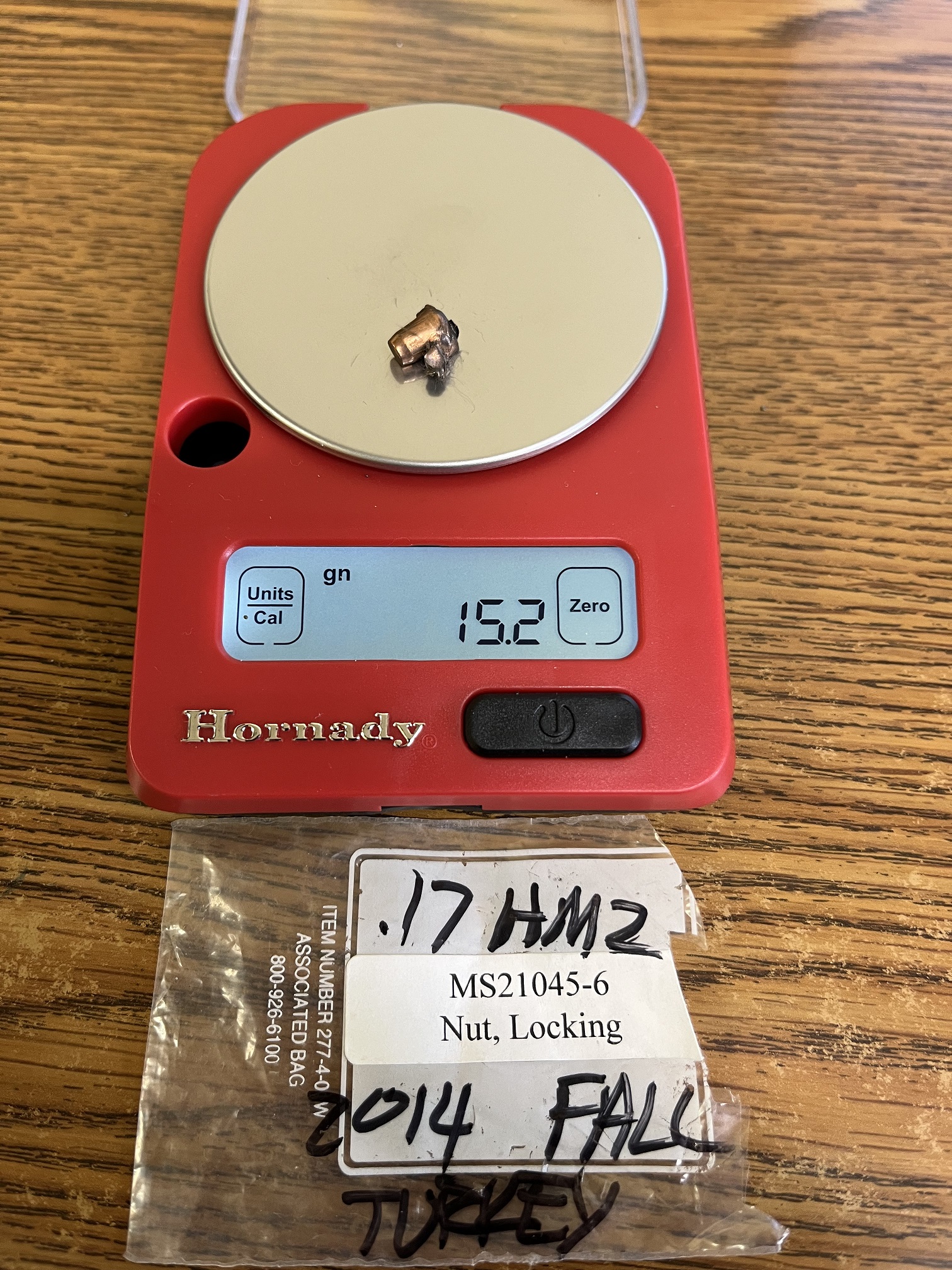
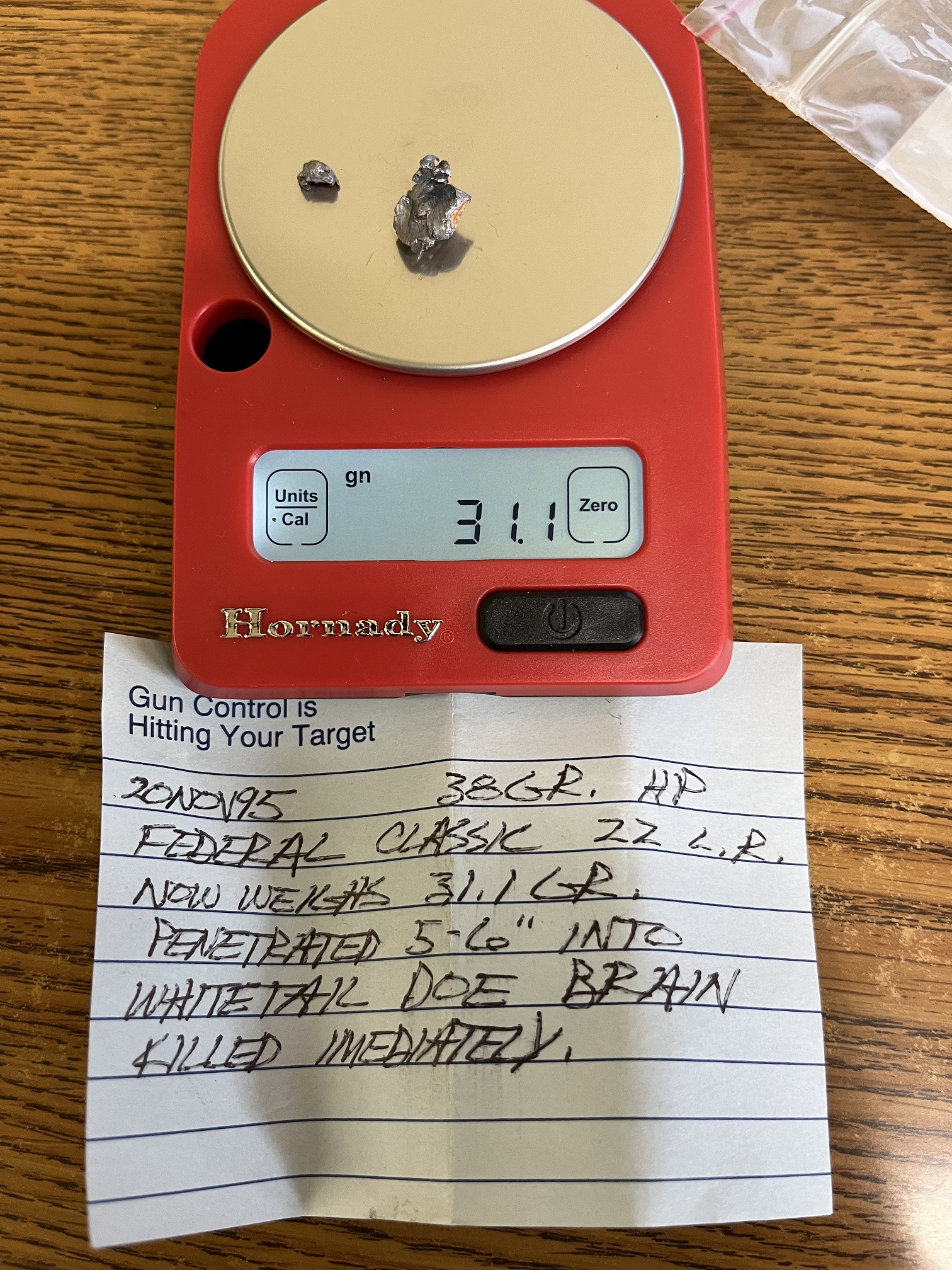
Rimfire one image is a bullet from Bitterroot Valley Ammunition’s .22 WMR starting as a 40 gr. cup & core style now weighing 6.7 grains. The 60 yard shot was into the neck on the throat patch of a whitetail and the bullet penetrated into the spine. The deer instantly dropped where it stood. Rimfire 2 image is what remains from a Hornady .17 HM2 .17 grain bullet. It now weighs 15.2 grains – not bad. This was recovered from a fall turkey. Rimfire 3 image shows the remains of a common lead .22 LR bullet fired into the brain. The deer dropped where she stood. I should comment that in Montana it is legal to hunt big game with a rimfire. There are no caliber limitations or minimum cartridge restrictions. Sally and I have shot a half dozen or so whitetails with the .22 WMR and one with the .22 LR. Head/neck shots are our choice at closer ranges.
Cup & Core Bullets:
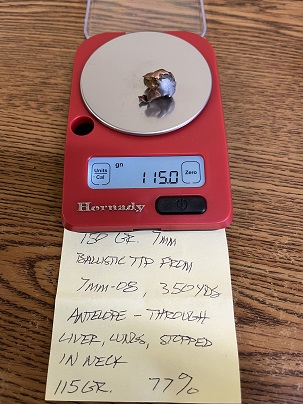
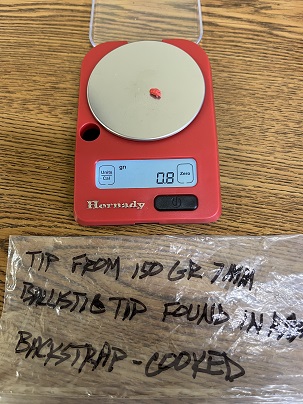

C&C 1 For a Ballistic Tip bullet this 150 gr. from a 7-08 performed well retaining 77%. The range of 350 yards and lower velocity helped. This was an antelope hunt and the bullet ranged through the vitals into the neck where it was found. C&C 2 This all that was found from a 150 gr. Ballistic Tip from a Montana Big Horn ram I shot in 2014. The bullet was a pass-through but the plastic tip ended up in a piece of backstrap on my dinner plate! C&C 3 This 150 gr. Ballistic Tip was fired by Sally Lilja at under 100 yards into the ribs of a cow elk. 30% retention.
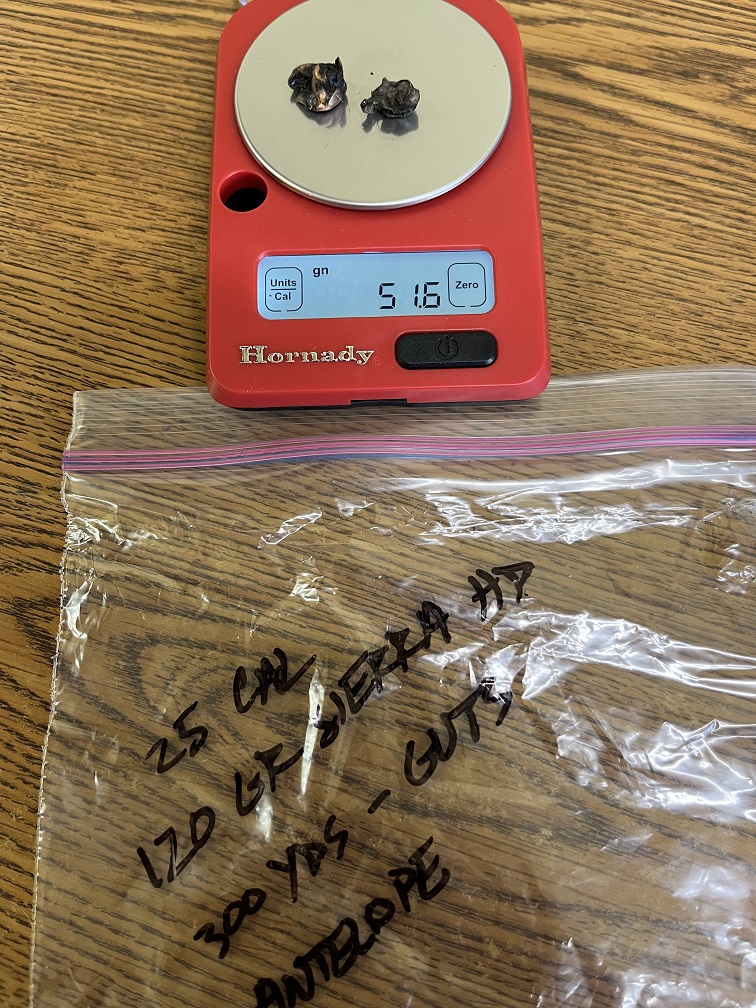
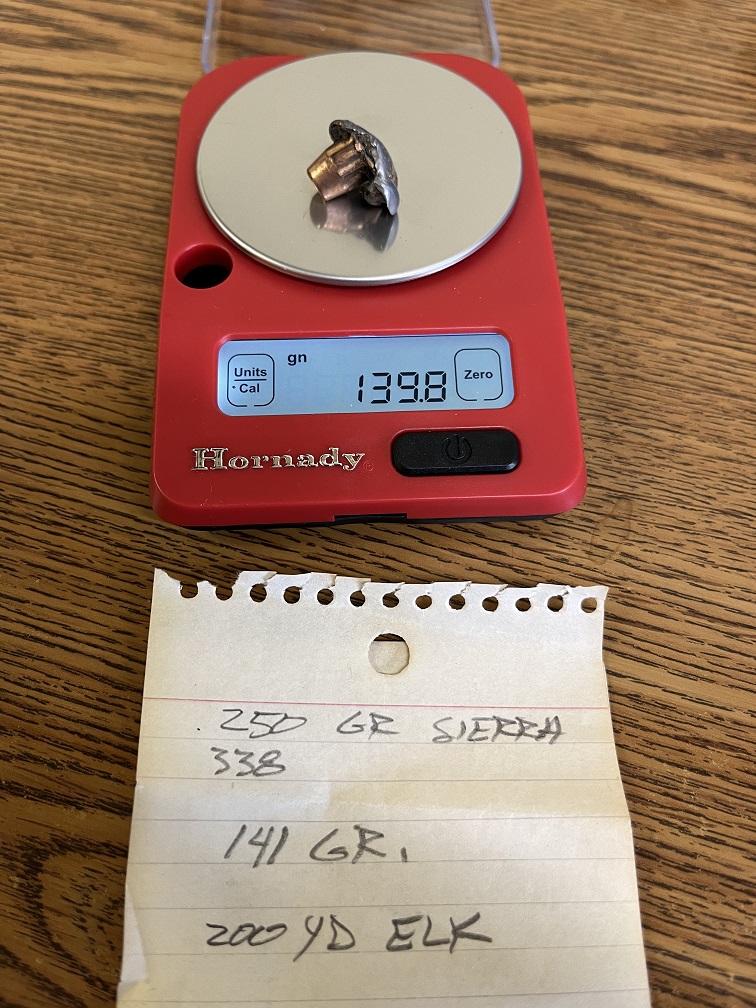
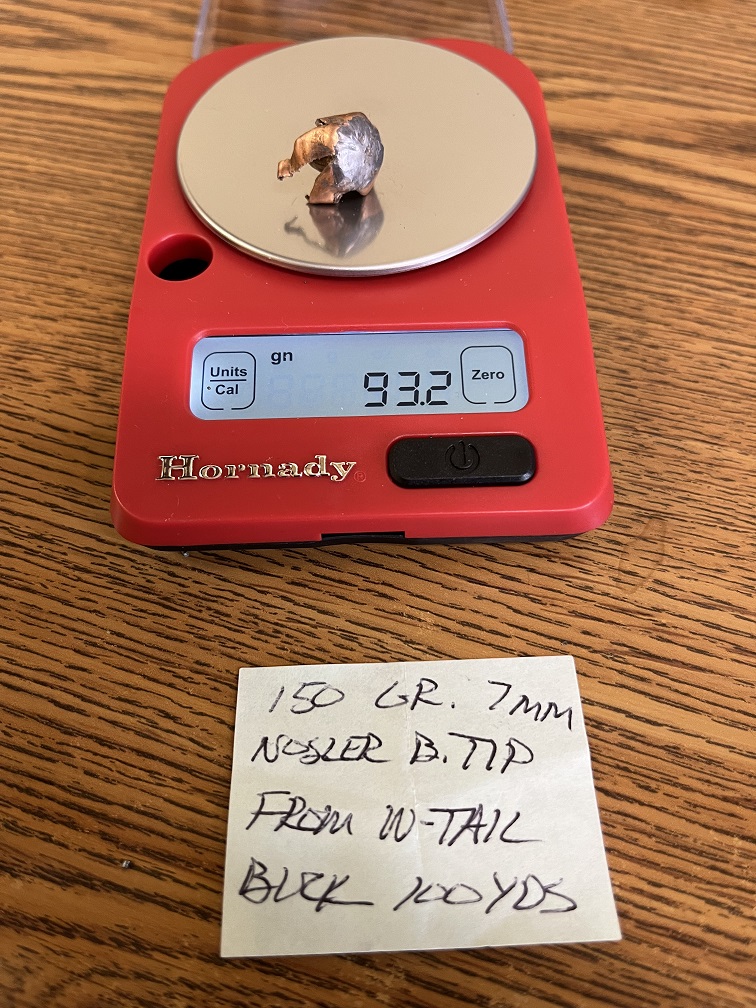
C&C 4 This is a 120 gr. Sierra Game king in .25 caliber fired from a .257 Wby Mag. Even at 300 yards the velocity is fairly high for a cup & core type bullet from this rifle and the 51.6 gr. remains show the result. In an antelope though it doesn’t make a lot of difference and the explosive bullet performance can make for extremely quick kills – as in before the animal hits the ground. 43% but in two pieces. C&C 5 This is a 250 gr. Sierra Game King from a cross-canyon cow elk at about 200 yards. A through-the-ribs shot and the bullet stopped in the off-shoulder area. A 70% retention is good for a C&C bullet but my experience with these big .338 caliber Game Kings has been excellent. There is one more of this excellent bullet shown further down (C&C 9). C&C 6 Another 150 gr. Ballistic Tip from a 7-08 and a whitetail buck. 62% retention. My notes and memory don’t tell me more than this.


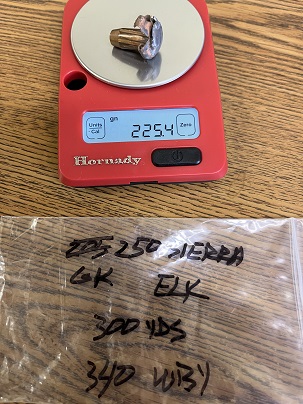
C&C 7 This is an interesting recovery; a 69 gr. hollow point benchrest type bullet that I made when I was shooting in competitive matches. It was made with a .900″ length J4 jacket and pointed in a Pindell die. The gun was an XP-100 handgun with a 15″ long barrel chambered for the 6X47. I shot two does with this combination but this was the only recovered bullet. It broke apart but was a quick kill. C&C 8 A 180 gr. Ballistic Tip from a .300 Win Mag. Deadly on this mule deer but probably not the best choice for elk unless a chest area shot was available without hitting shoulder. The core has separated from the jacket which is common with this combination. 56% including both the jacket and core. C&C 9 Another 250 gr. Game King from the .340 Wby and another dead elk at 300 yards. This was a big 6 point bull and a broadside shot with the bullet against the off-side hide. I recall another cow elk I shot with this same combination at 330 yards. She was facing directly at me and my son Travis, although unaware of us, as we glassed her from some pines. I aimed at the center of her brisket and at the impact her front legs came off the ground and she flipped over backwards. The bullet travelled the full length and stopped in a hind quarter. I’ve had similar instant kills with the 250 Game King and big mule deer bucks, a big whitetail buck, a caribou, and two shots on a British Columbia moose. I shot a B&C black bear with this also. Although the first shot would have killed him I put in two more.
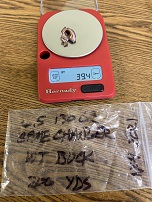
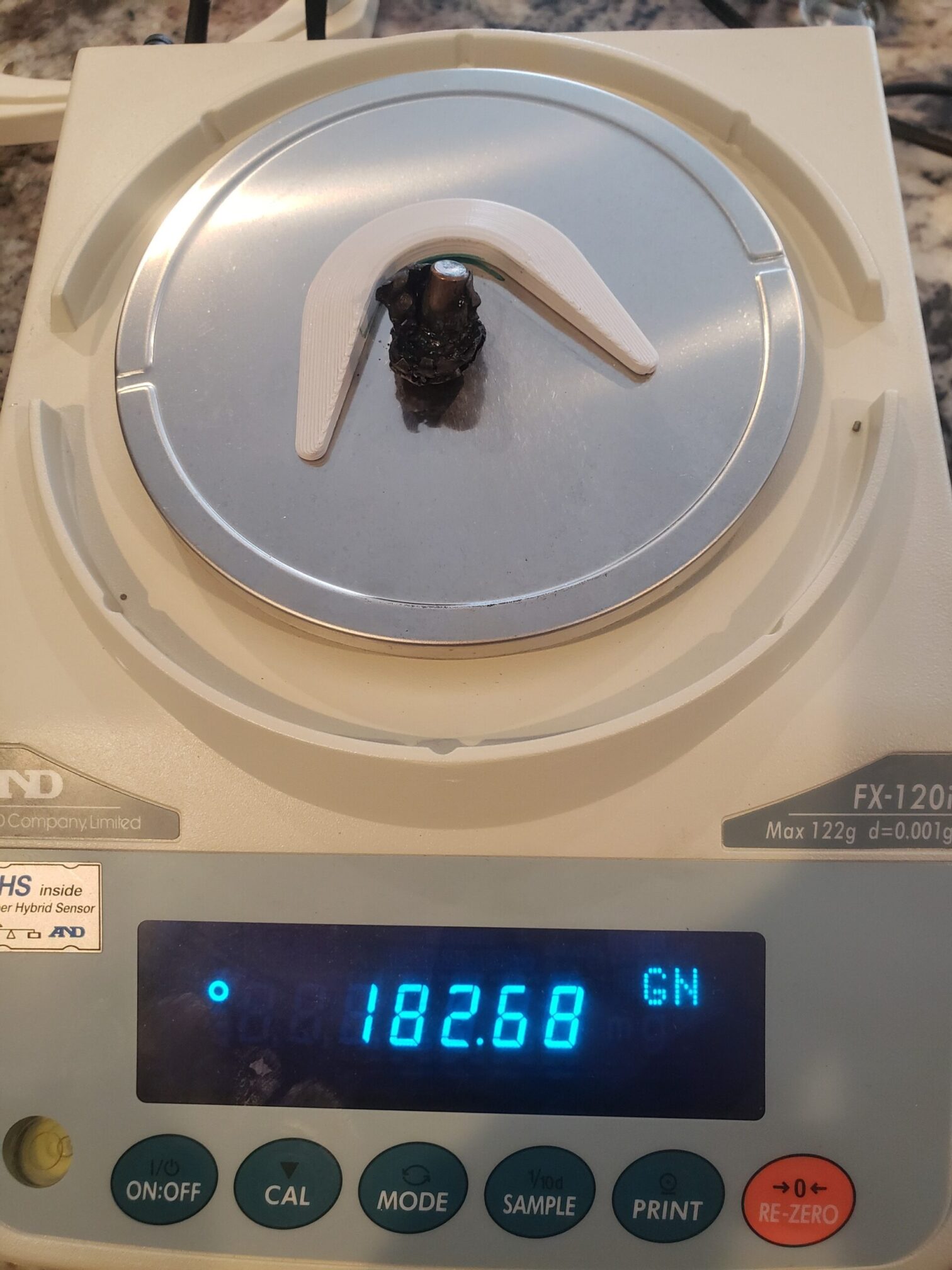
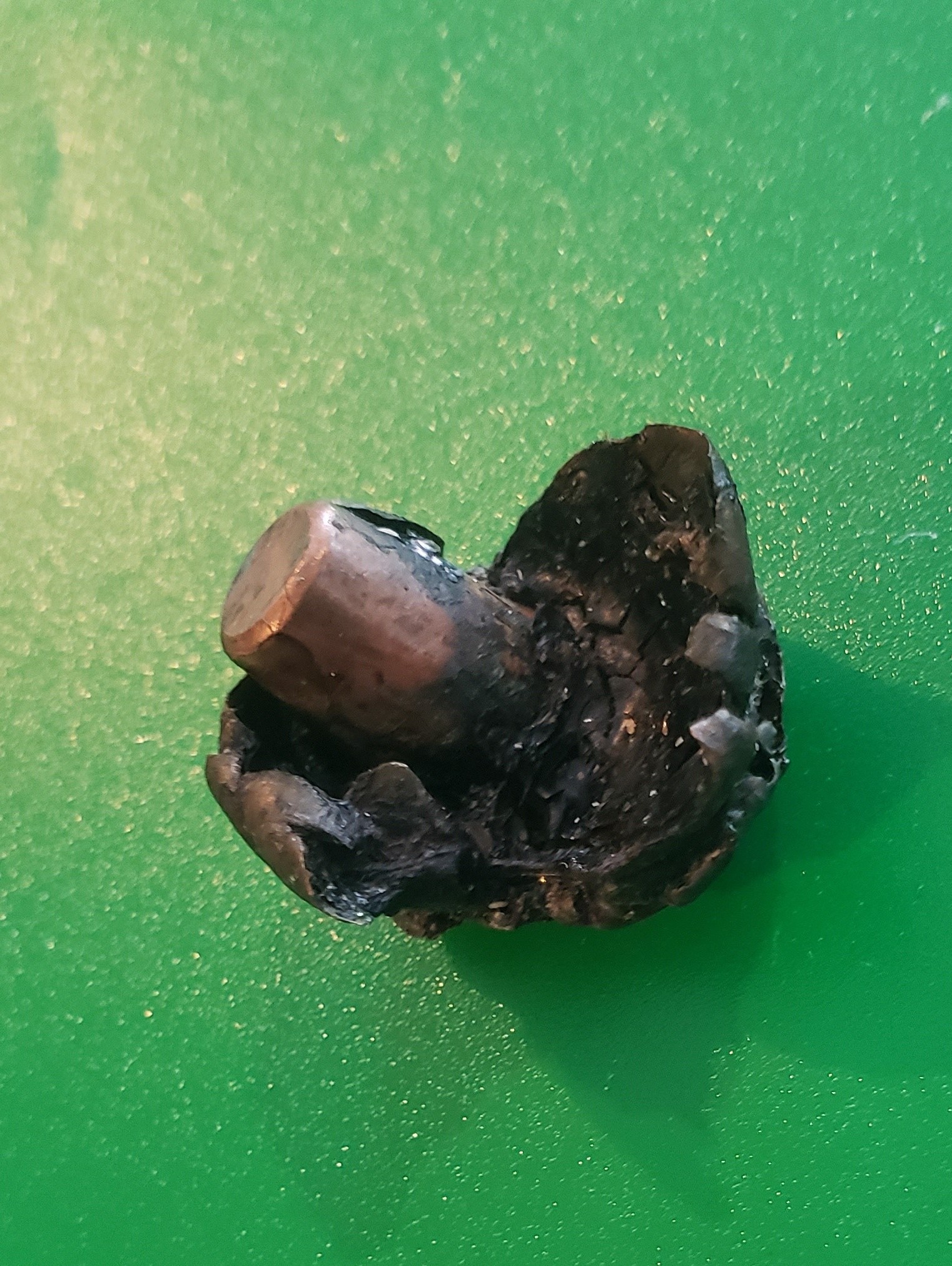
C&C 10 This bullet is the most disappointing of all of the recovered bullets. It is a .264 caliber Sierra Game Changer (These are called a Tipped Gameking now) in 130 gr. fired from a 6.5 Creedmoor at a whitetail buck. The range was 200 yards and the bullet blew up on the entrance side of the ribs! The buck dropped and was dead but only because some of the core entered the lungs. A friend in Alberta had a very similar experience with a Game Changer in a .270 Winchester on a mule deer hunt and a follow up shot was required. C&C 11 is a bullet from Kody McDonald in 2017 with these comments: “This was a shot taken on an Alaskan moose through the heart at 550 yard from a 338-378 Berger 300 grain Elite Hunter bullet MV 2900. The bullet was just under the skin on the far side shoulder.” C&C 12 is another look at C&C 11. 61% retention on this big .338 bullet.
Partition Bullets:
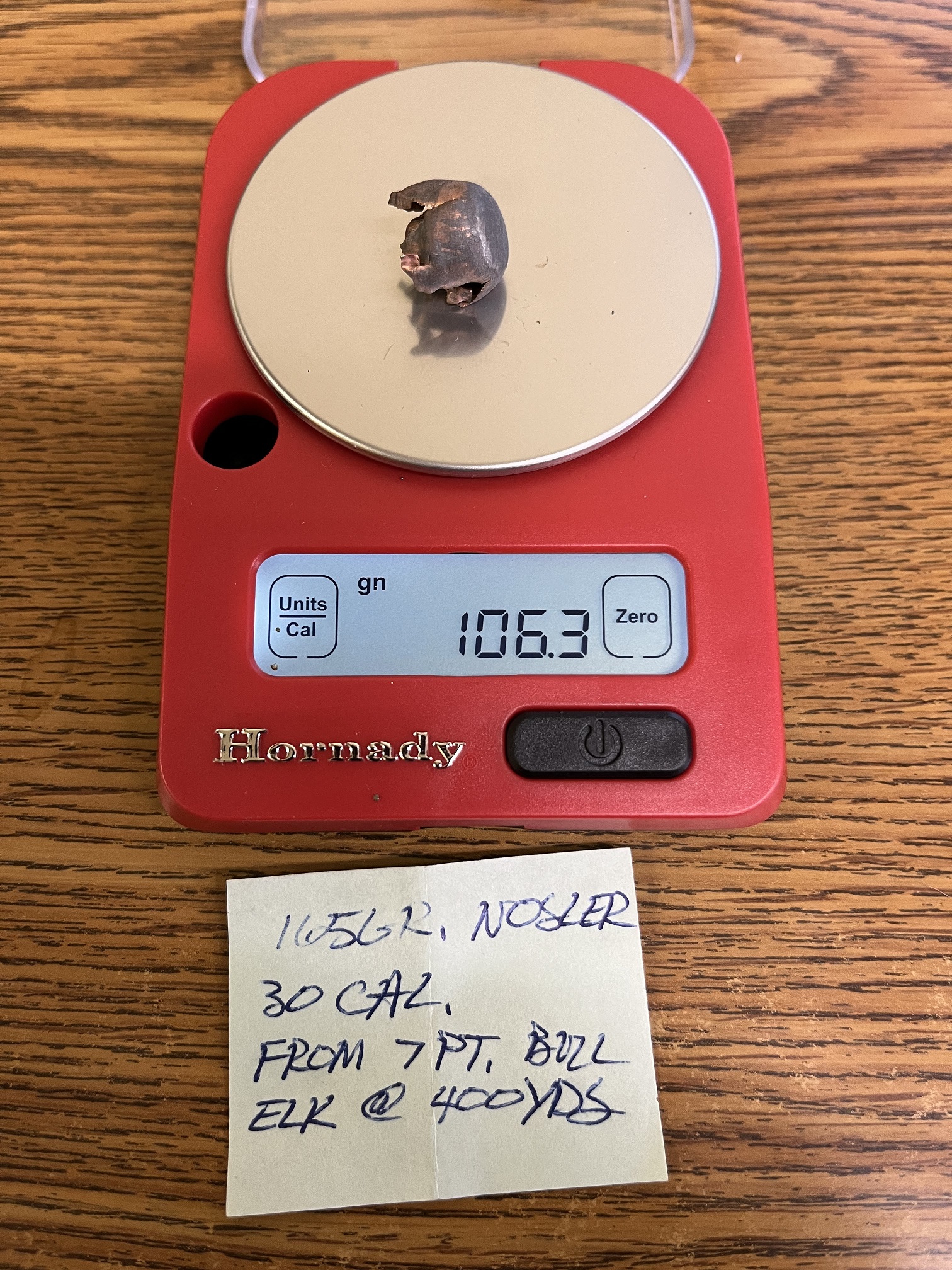
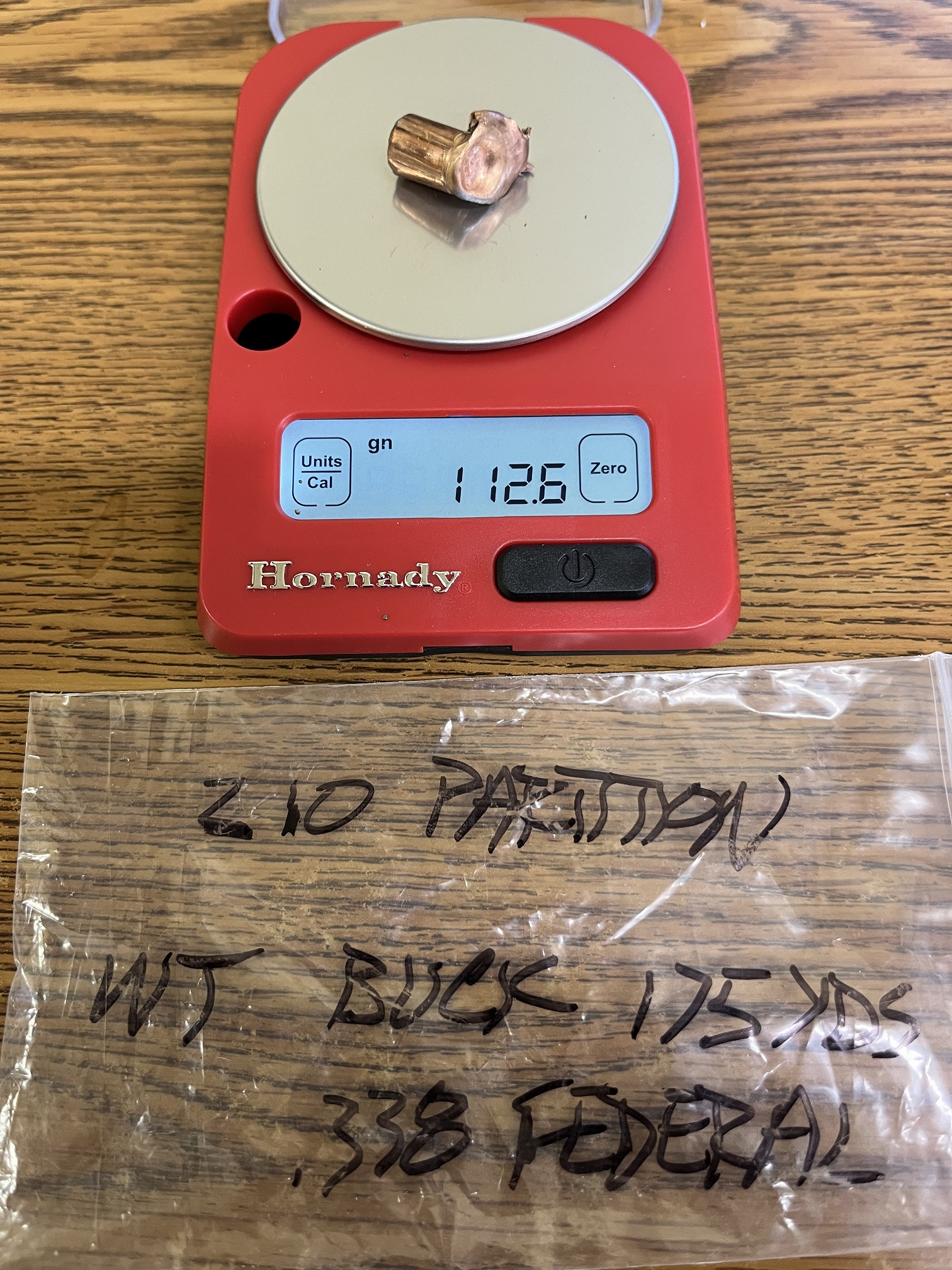
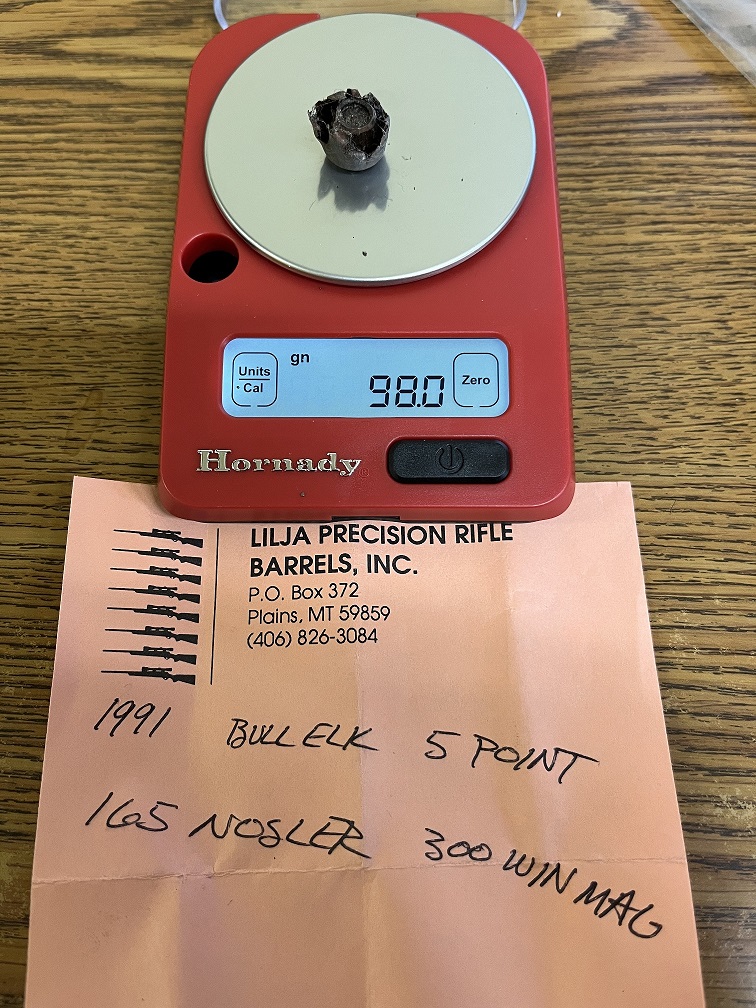
Partition 1 is a 165 grain .30 caliber Nosler Partition from my biggest bull elk with a .300 Win Mag in 1994. The shot was about 400 yards through the ribs and the bullet was recovered against the off side hide. 64% retention. Partition 2 This is a 210 gr. Nosler Partition fired from a .338 Federal. I was a little surprised this bullet was not a pass-through. A whitetail buck isn’t that wide broadside but the big bullet was stopped by the hide on the far side of the ribs. 53% retention. Partition 3 this is another 165 gr. Nosler Partition from a .300 Win Mag. Even though this hunt was in 1991 I remember it well. Two friends and I spotted three bulls up high on a snowy open hillside early in morning. There was an old road that went up above these bulls and we were able drive up and then hike down the ridge, still-hunting as we went. It was my turn to shoot and we sneaked up on them at about 75 yards. I put the crosshair on one of the two five-points, the third was a spike, and put a bullet into the lungs on a quartering away shot. My note from my reloading log says that he “stumbled 30′ and dropped”. One of the guys had a chainsaw winch and we drug him whole about 300 yards up to the road we’d parked on. The next morning we glassed the same slope from where we’d seen them the previous morning and my buddy Jerry was first to see them again in about the same place. He wryly said: “There they are again this morning, just one short.” (59% retention) Unfortunately both of those guys are now gone…..
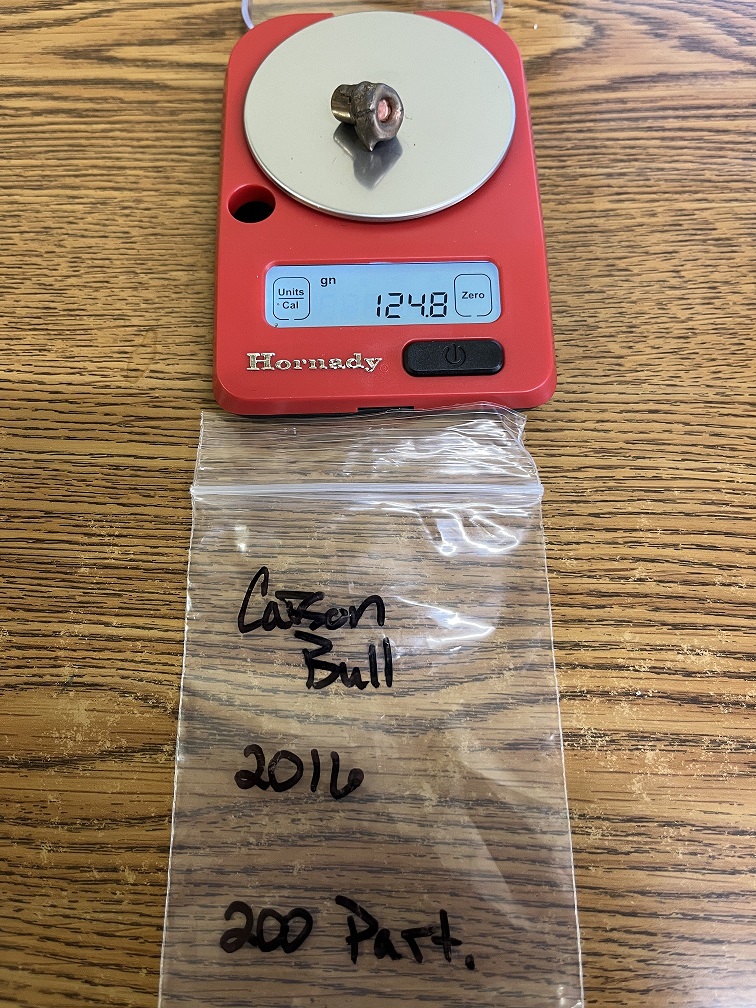
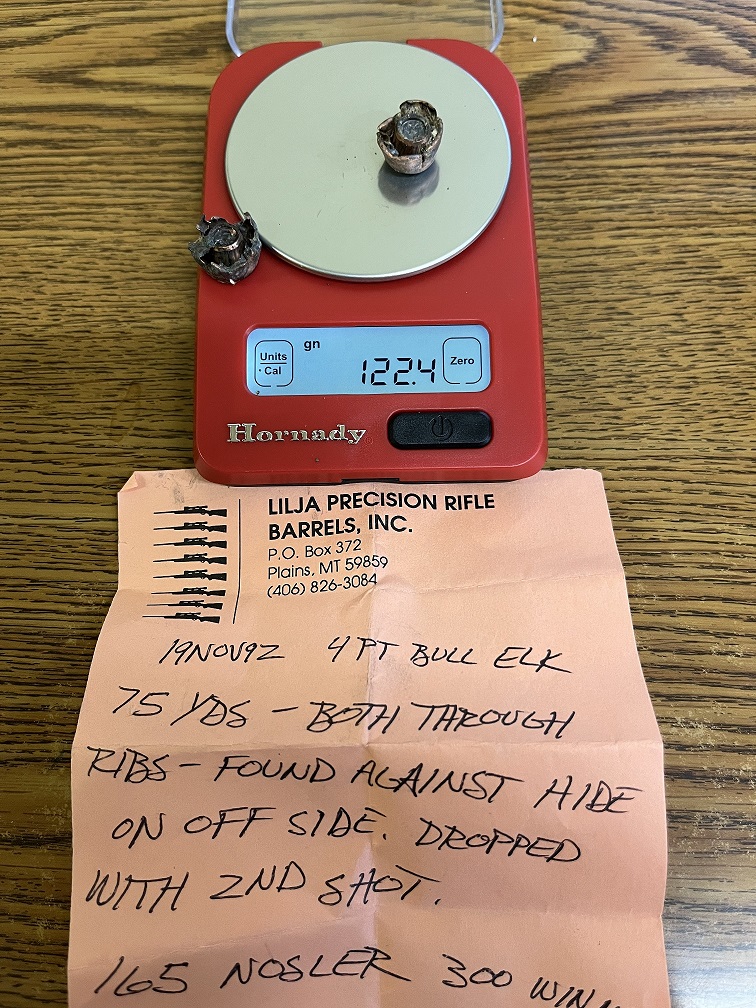
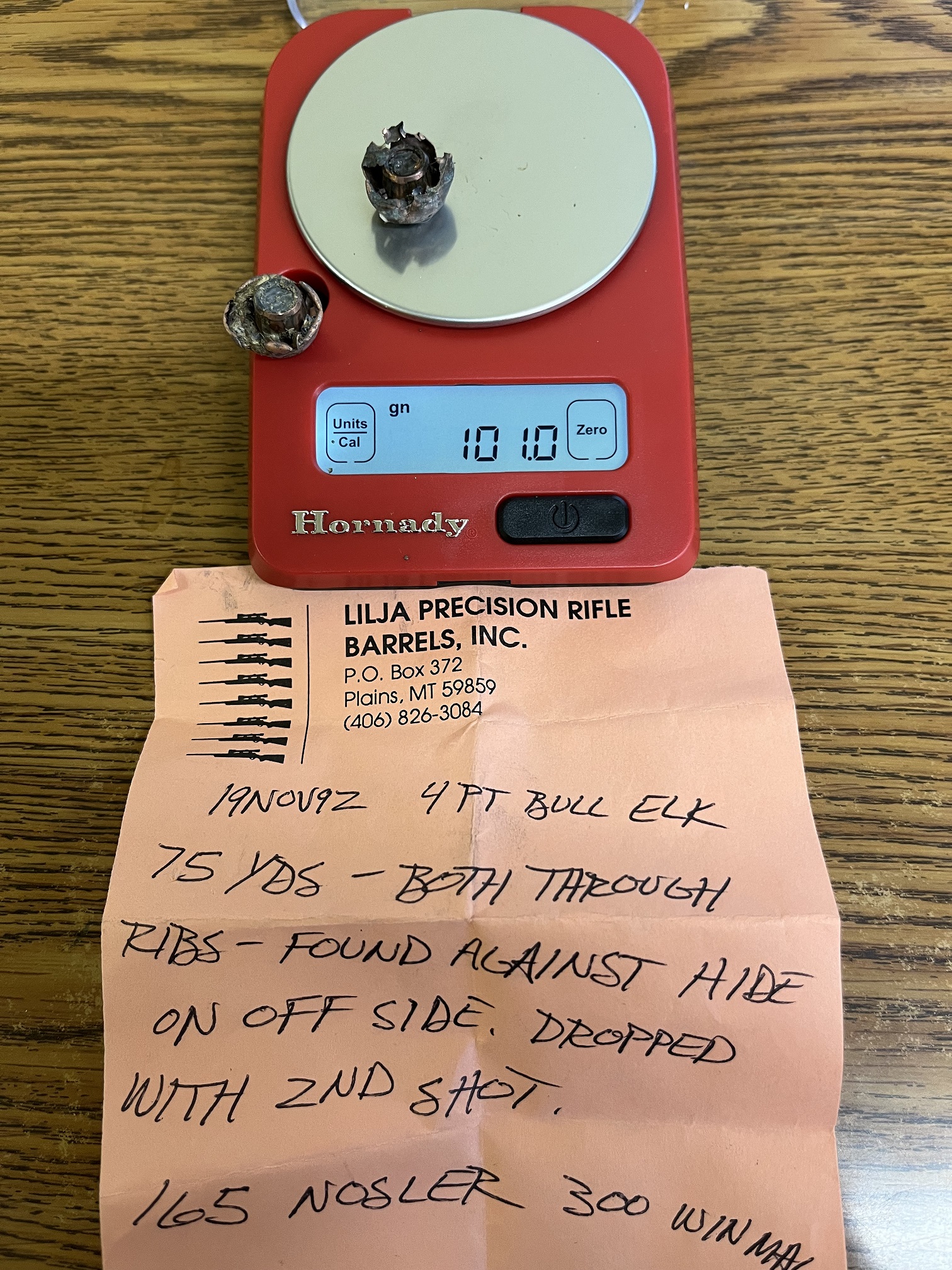
Partition 4 This is a 200 gr. Nosler Partition fired from a .300 Win Mag by Carson. The bull was out there at 430 yards and it was recovered on the off-shoulder when he was caping it. The year was 2016 and the retention is 62%. Partition 5 is from an elk shot with a .300 Win Mag and another 165 gr. Nosler Partition at 75 yards. It was recovered against the off-side hide in the rib area. Partition 6 is from the same elk and I remember after I found these bullets I thought to myself I wasn’t getting all the penetration I should be and considered switching to 180 gr. Partitions. This was in 1992 and partitions were the best controlled expansion bullets available then. 74% and 61% retention.
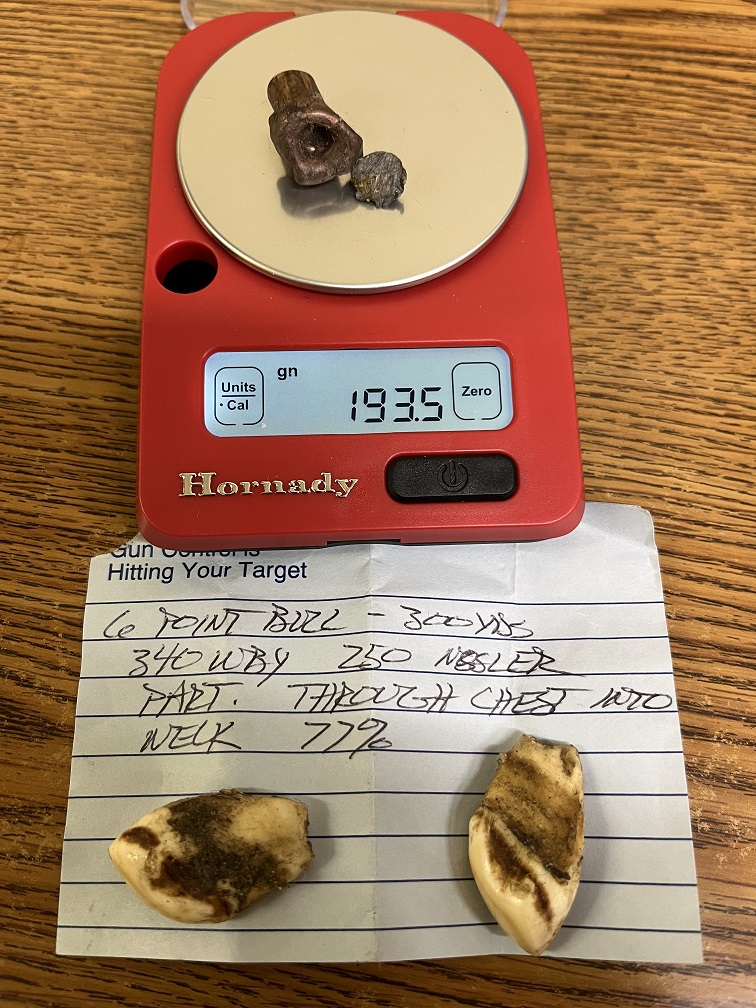
Partition bullets are an excellent choice for controlled expansion. The Noslers have been available for a long time now. The Swift A-Frame is another option and although I have not personally used them, I have friends that have, and they’re very satisfied with their performance.
Bonded Core Bullets:
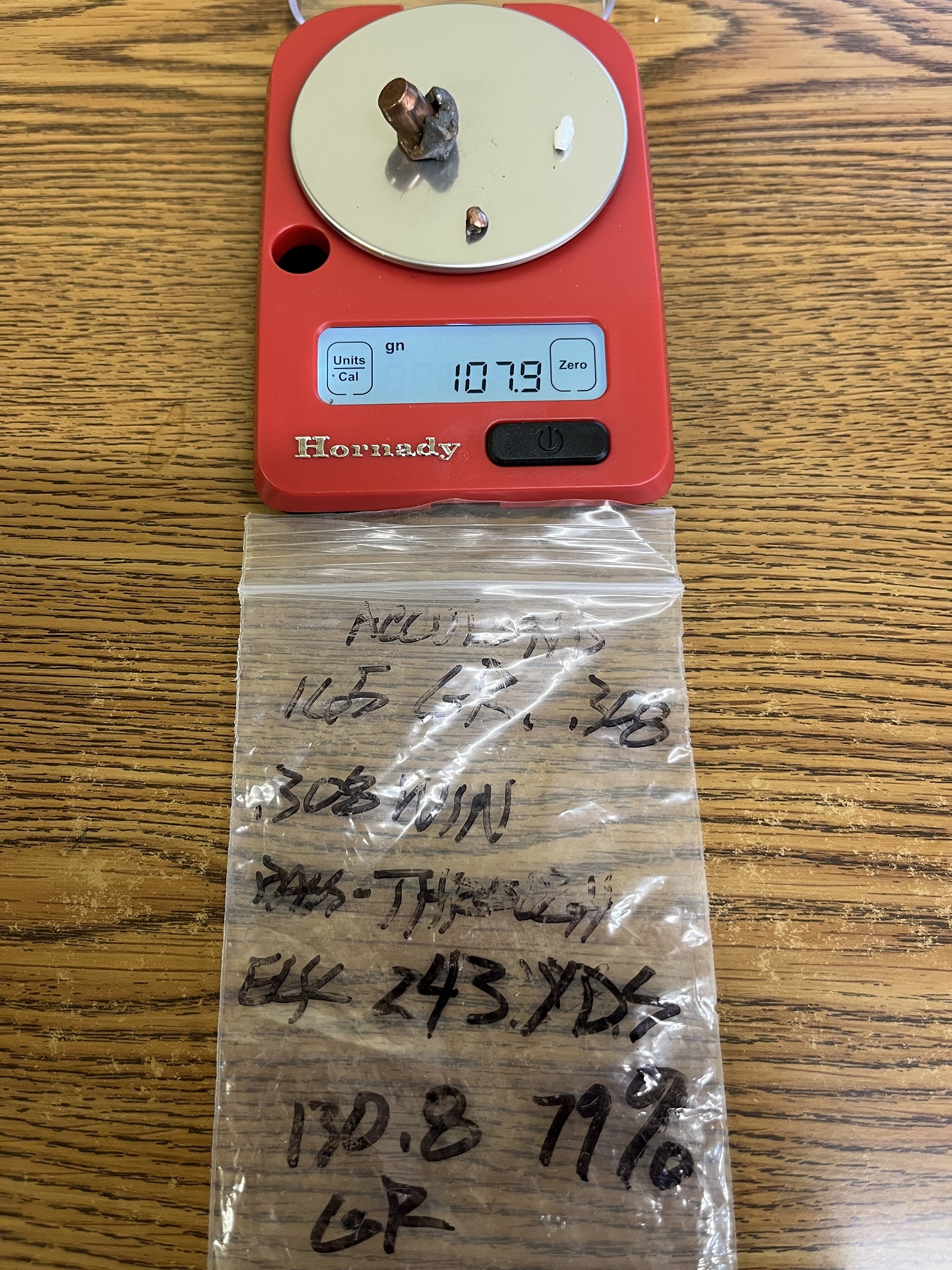
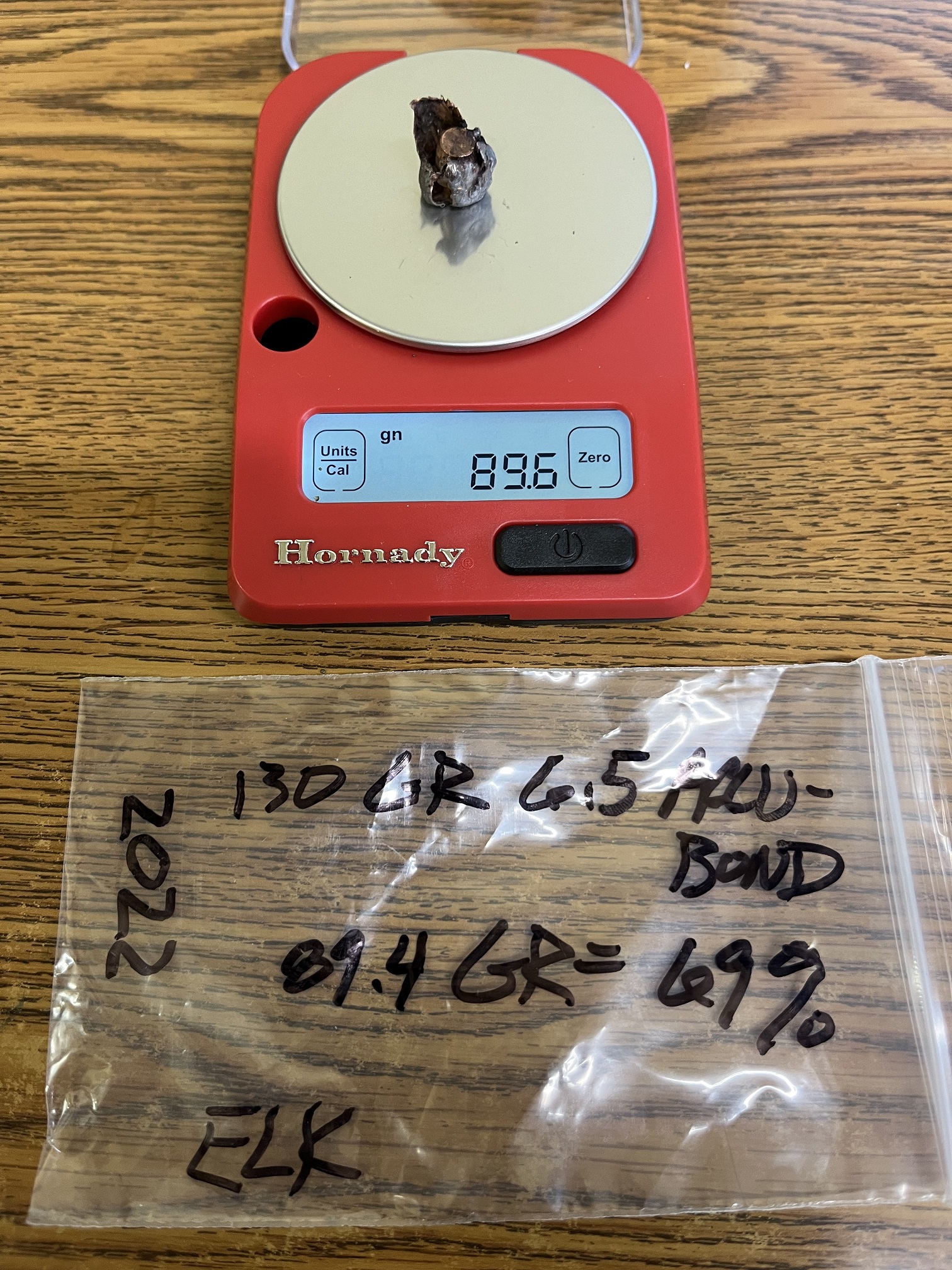
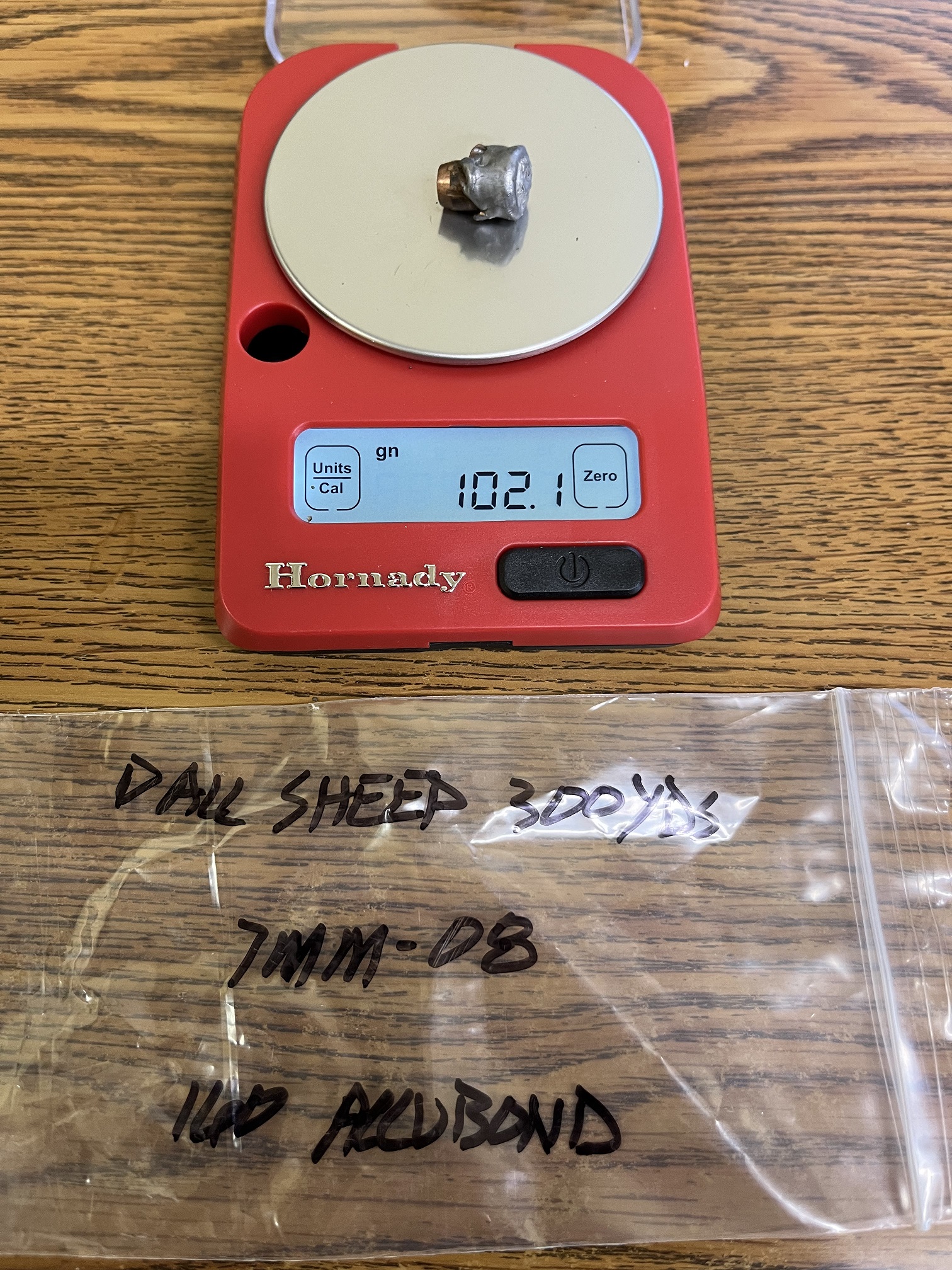
Bonded 1 is the 165 gr. Accubond .30 caliber bullet I mentioned at the beginning of this article. 79% retention. The white plastic tip and bit of copper were found skinning the bull. Bonded 2 is a 6.5 caliber 130 gr. Accubond from a bull elk fired by a 6.5 Creedmoor. Retained weight is 69%. A picture of this elk is at the end of the article. Bonded 3 is one of the most impressive recoveries, in my opinion. This bullet, a 160 gr. 7mm Accubond, is from a Yukon Dall ram I hunted in 2017. The ram was facing me and the bullet entered his brisket and travelled the full length of the ram. We found it next to the tail, boning out the meat! 64% retention.
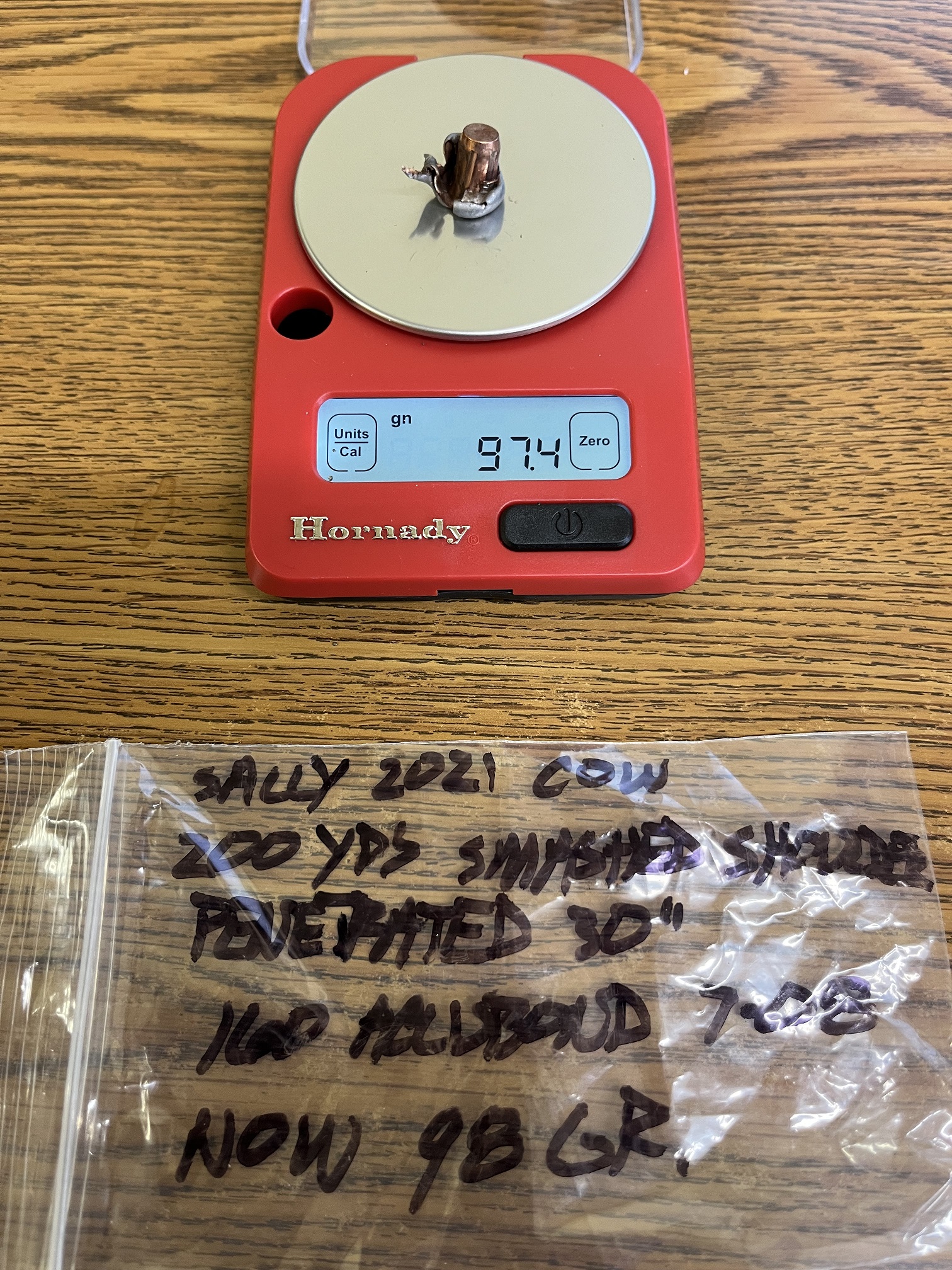
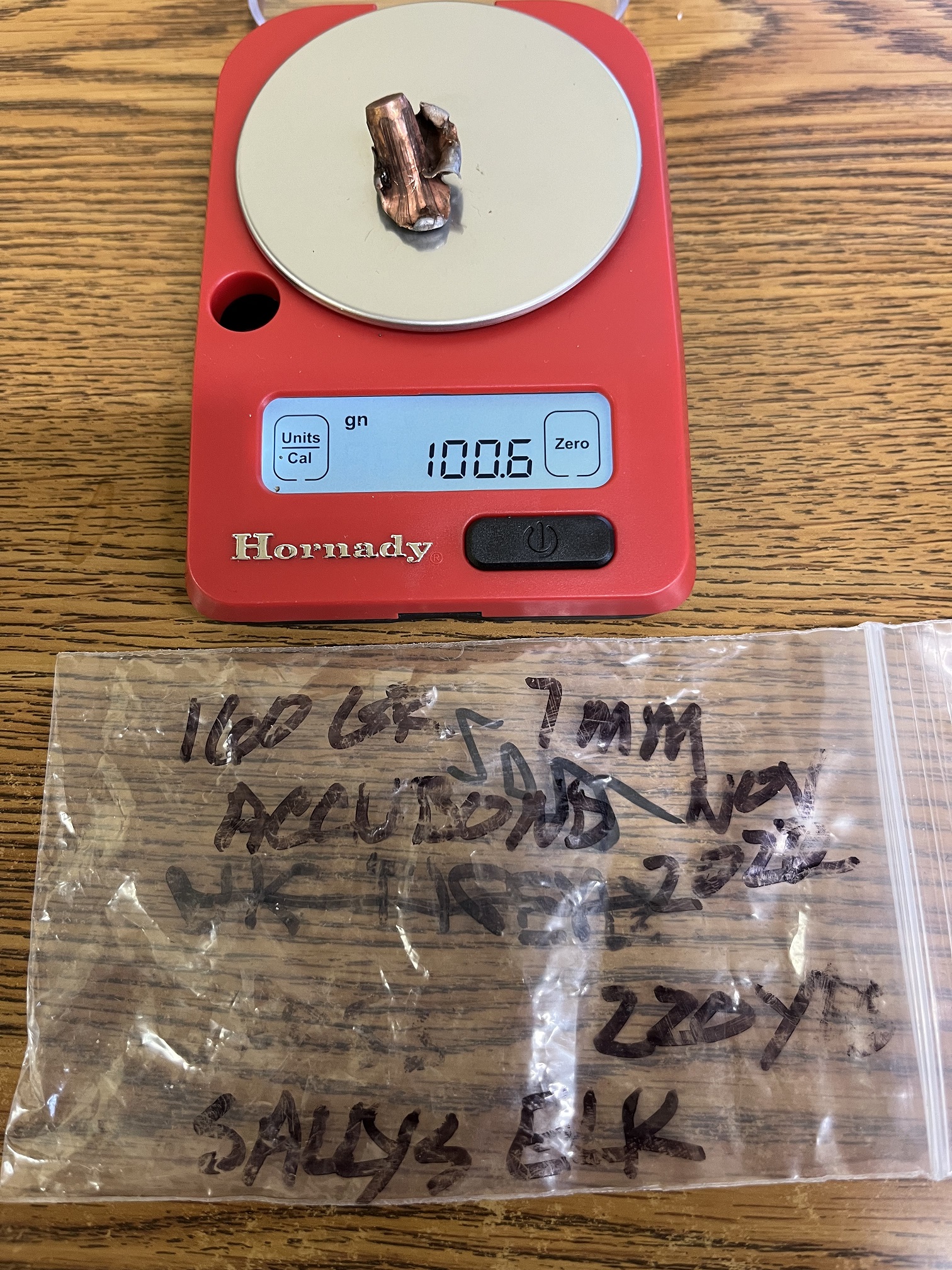
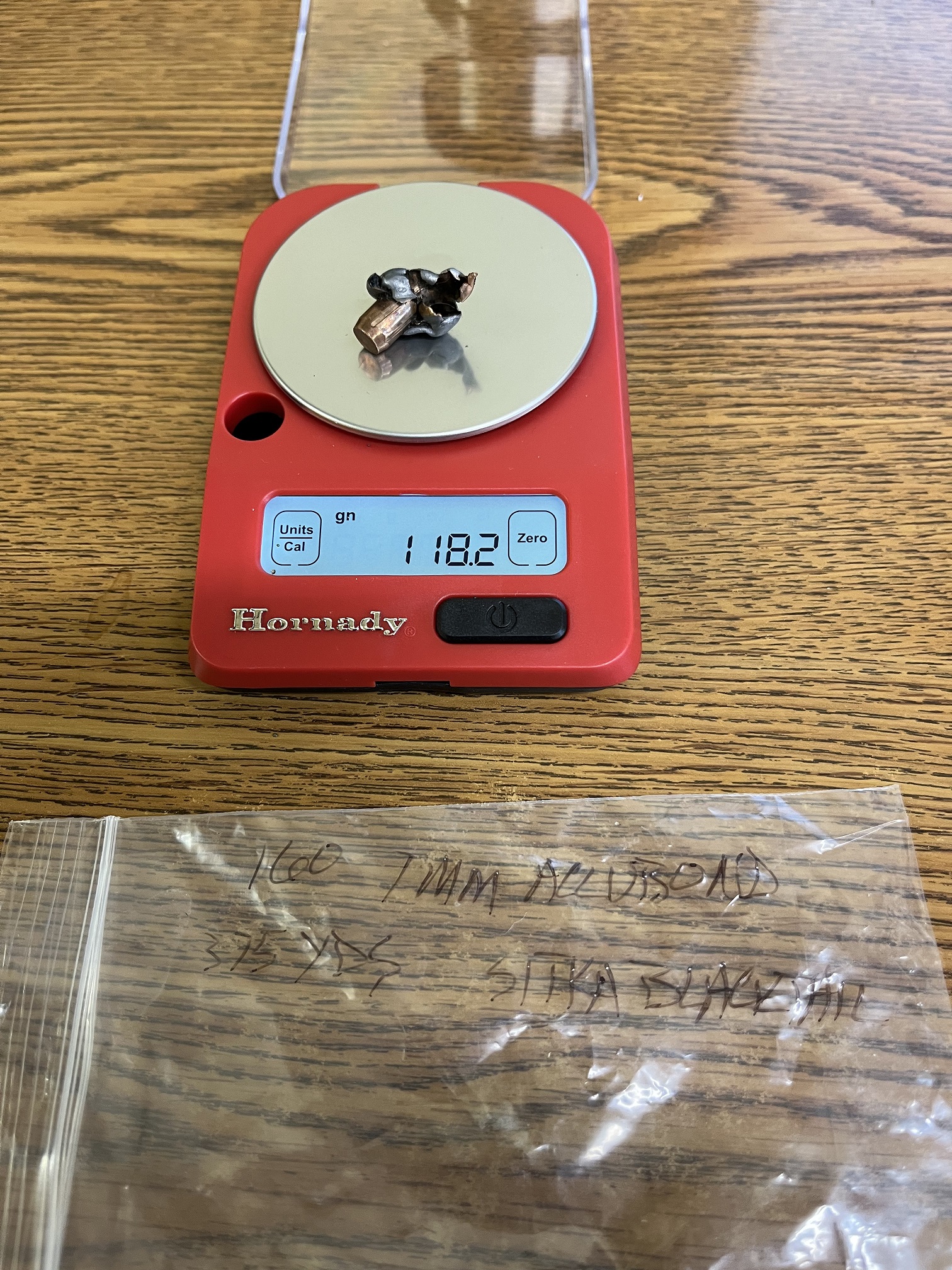
Bonded 4 is a 160 gr. 7mm Accubond from a 7mm-08 recovered from a cow elk. This was a more or less straight on shot at about 200 yards. The bullet hit the inside of a shoulder and broke bone before ranging on into the vitals and was found back near the diaphragm. About 30″ of penetration. This cow surprisingly did not drop at the shot. It took a couple of steps forward and not knowing where the bullet had hit, Sally took another shot at the exposed head. The chest area was hidden by a big ponderosa pine. This dropped the elk but is another example of how tough these elk can be. Bonded 5 is another 160 gr. 7mm Accubond from a cow elk killed by Sally and her 7mm-08. This cow was in the open and she made a nice 220 yard shot at the broadside cow. The bullet hit a shoulder bone entering and was found against the hide on the far side. 63% retention. Bonded 6 is another 7mm 160 gr. Accubond recovered from a Kodiak Island Sitka Blacktail. This was a longer shot at about 375 yards and the bullet was recovered against the hide on the far side. With big brown bears looking for an easy meal before hibernating a heavy bullet with controlled expansion is appreciated.
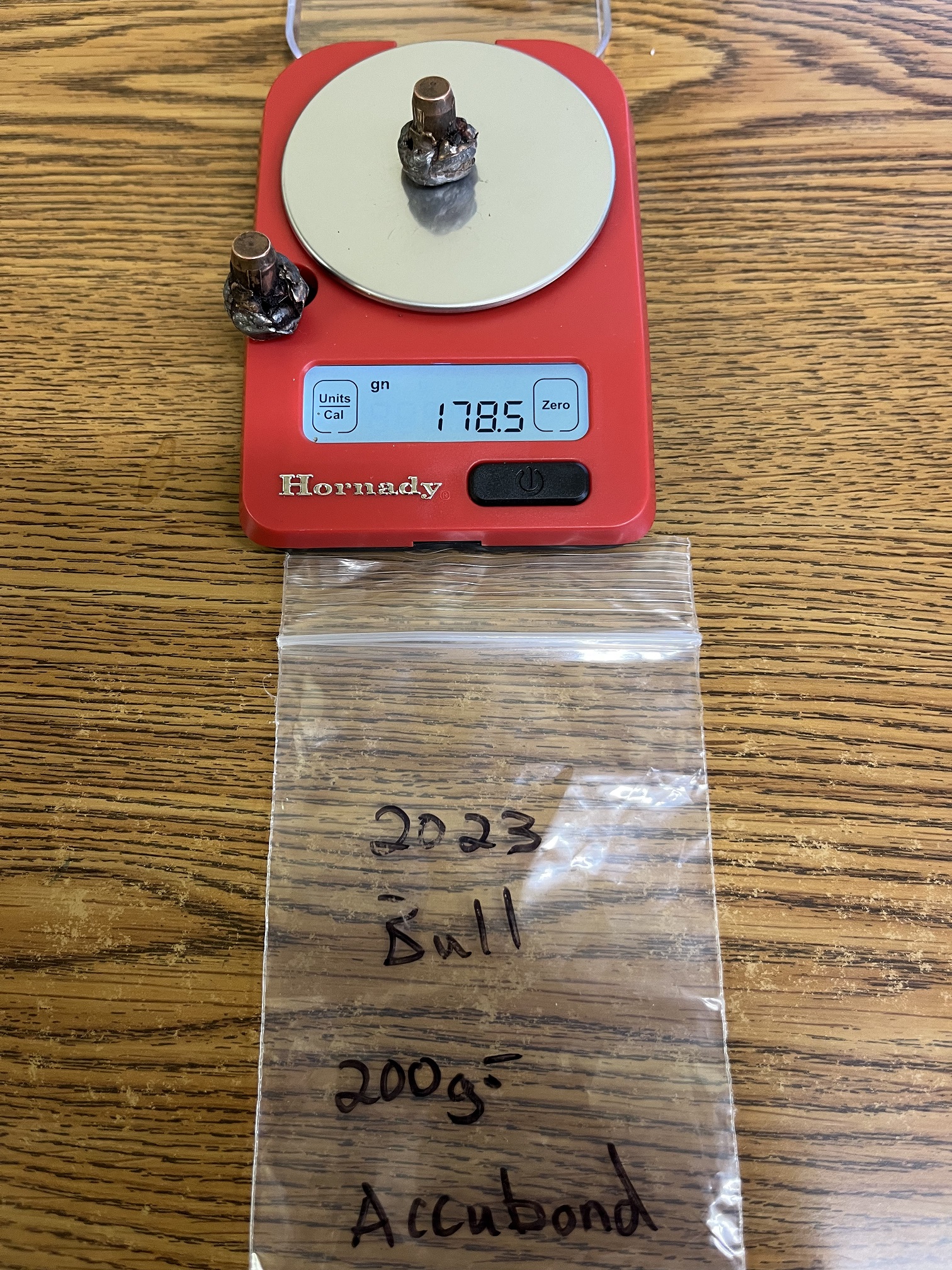

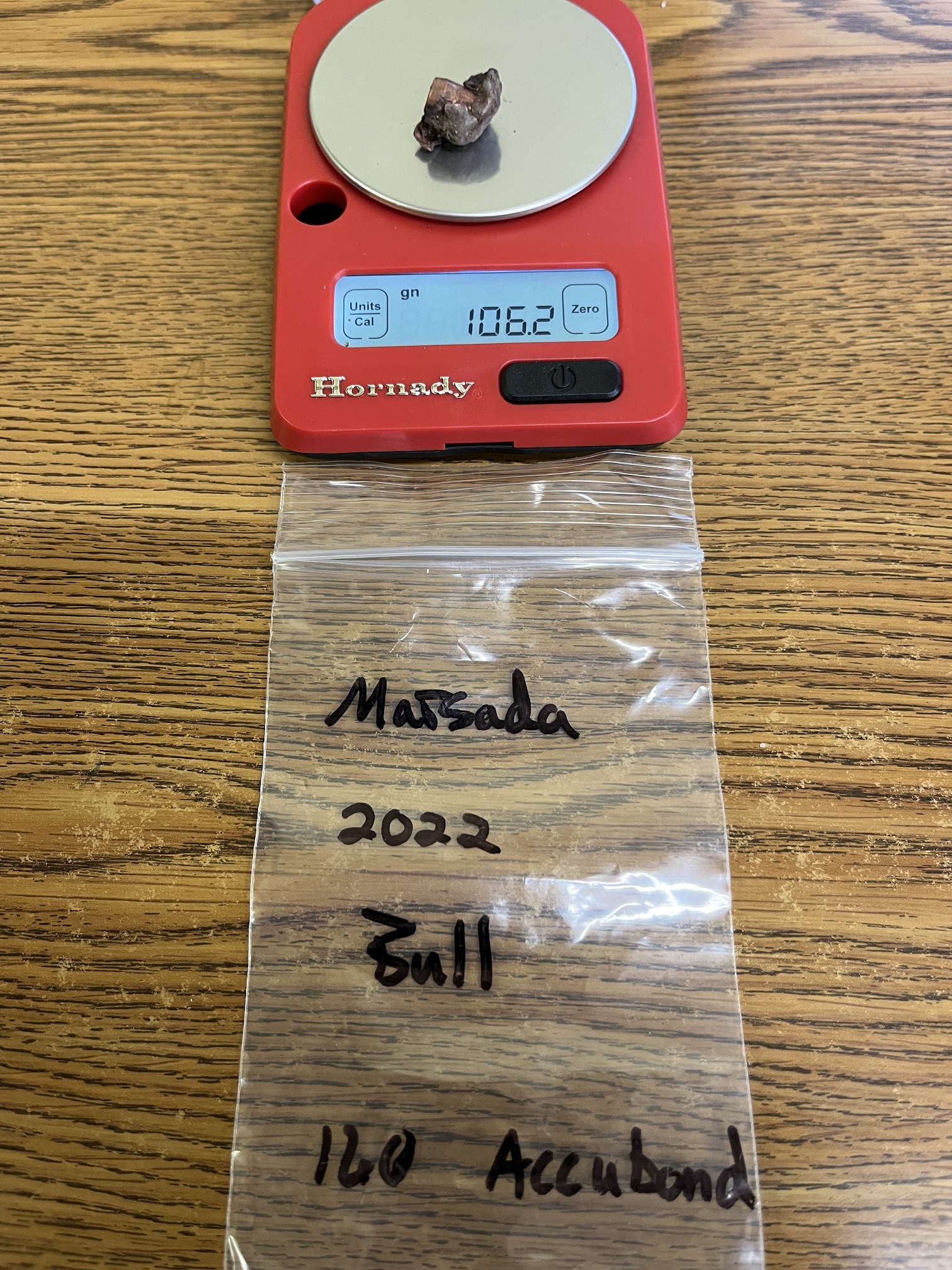
Bonded 7 and Bonded 8 are both 200 gr, Accubond .30 caliber bullets fired from a .300 Win Mag by Carson. He and a friend packed in on their horses in October of 2023. The morning of opening day they spotted two bulls at a little over 400 yards. Carson put two bullets into his broadside bull and both were found against the hide. 89% retention for both. Bonded 9 is another 7mm-08 160 gr. Accubond recovered from a bull elk. Marsada shot this bull at about 175 yards when it stood up out of his bed. It was a broadside shot and the bull walked about 50′ following the shot. The bullet was found against the hide on the far side. 66% retention.
Bonded bullets are an excellent choice when hunting big animals like elk. They break bones and keep on plowing through reaching the vitals from almost any angle. The earliest bonded bullets I bought were Bitterroot Bonded Bullets. I purchased some .30 caliber 180 gr. bullets at a gunshow in the 1980’s. They were made in Salmon, Idaho. The bonded bullets that I’m aware of available today are the excellent Accubond and two offerings by Federal. Federal makes the Fusion line and the polymer tipped Terminal Ascent. At the 2024 Sheep Show I visited with a Federal Rep about these and if I understood him correctly these are both a heavily plated bullet. I have some 200 gr. Fusions in factory loaded .338 Federal ammo but I have not used them on game yet. The Accubonds are an excellent choice for any big game hunting but especially on elk size animals and larger. We’ve used a lot of these in the 7mm-08. Though the 140s would be a good choice in this cartridge the 160s have performed so well, and are so accurate, that we haven’t found a need to switch. My good friend Alex drew the only non-resident sheep tag in western Montana in 2024. He chose a .300 Win Mag shooting the 200 grain Accubond. This was a wise choice and the heavy bullet did the job passing through the lungs. The ram died almost instantly. Who would choose a lesser bullet for such an important shot?
Copper:
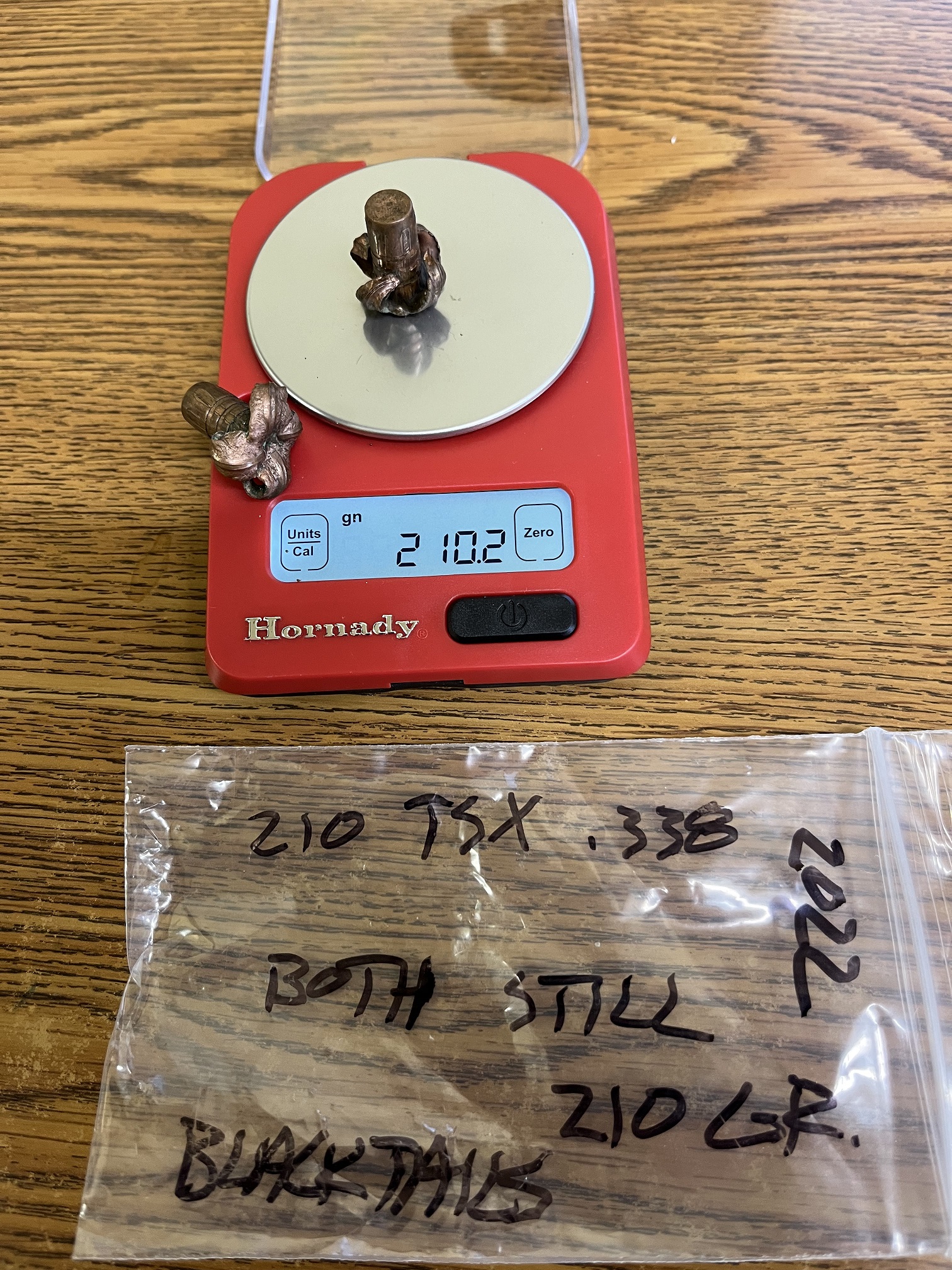
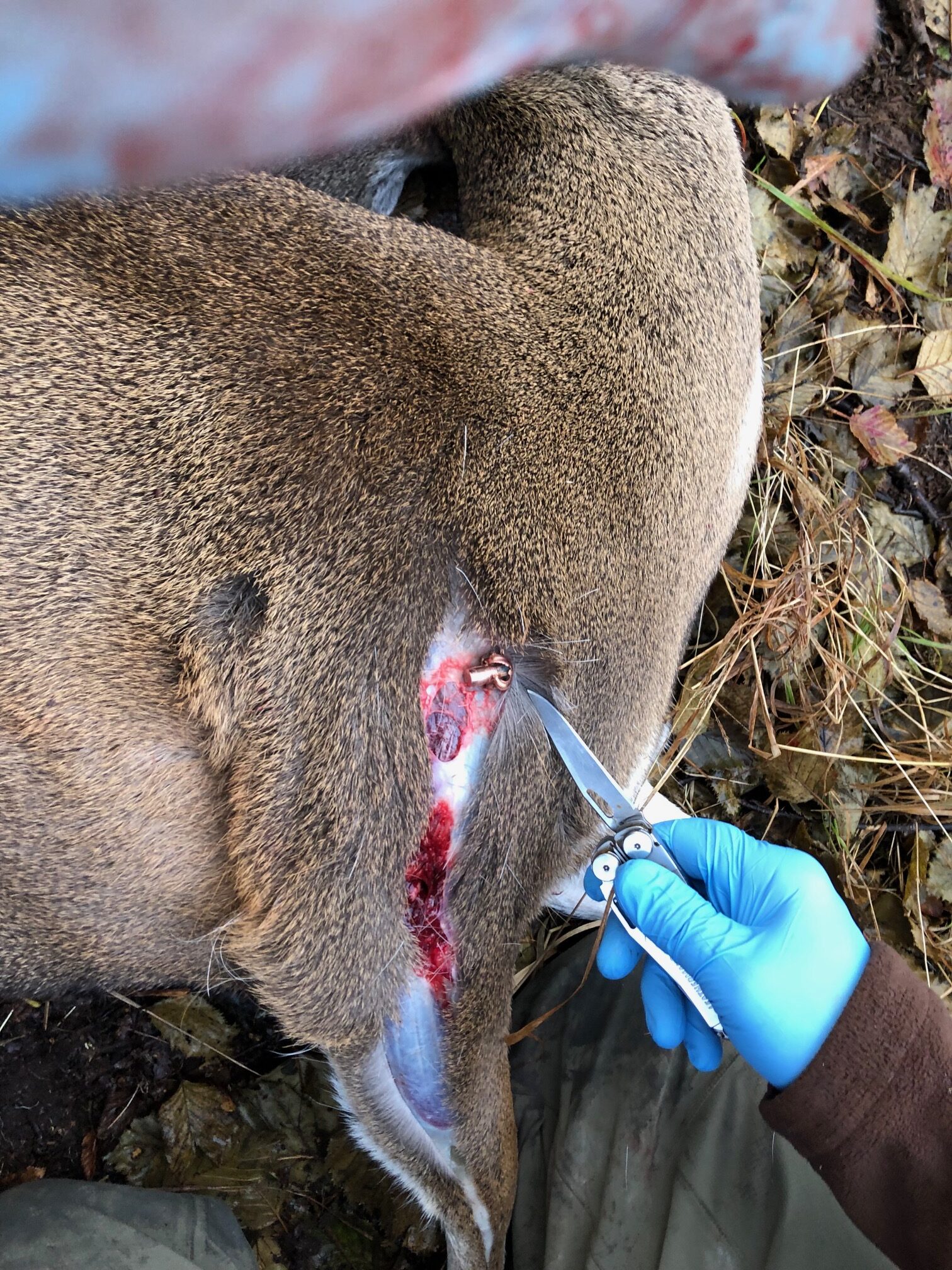
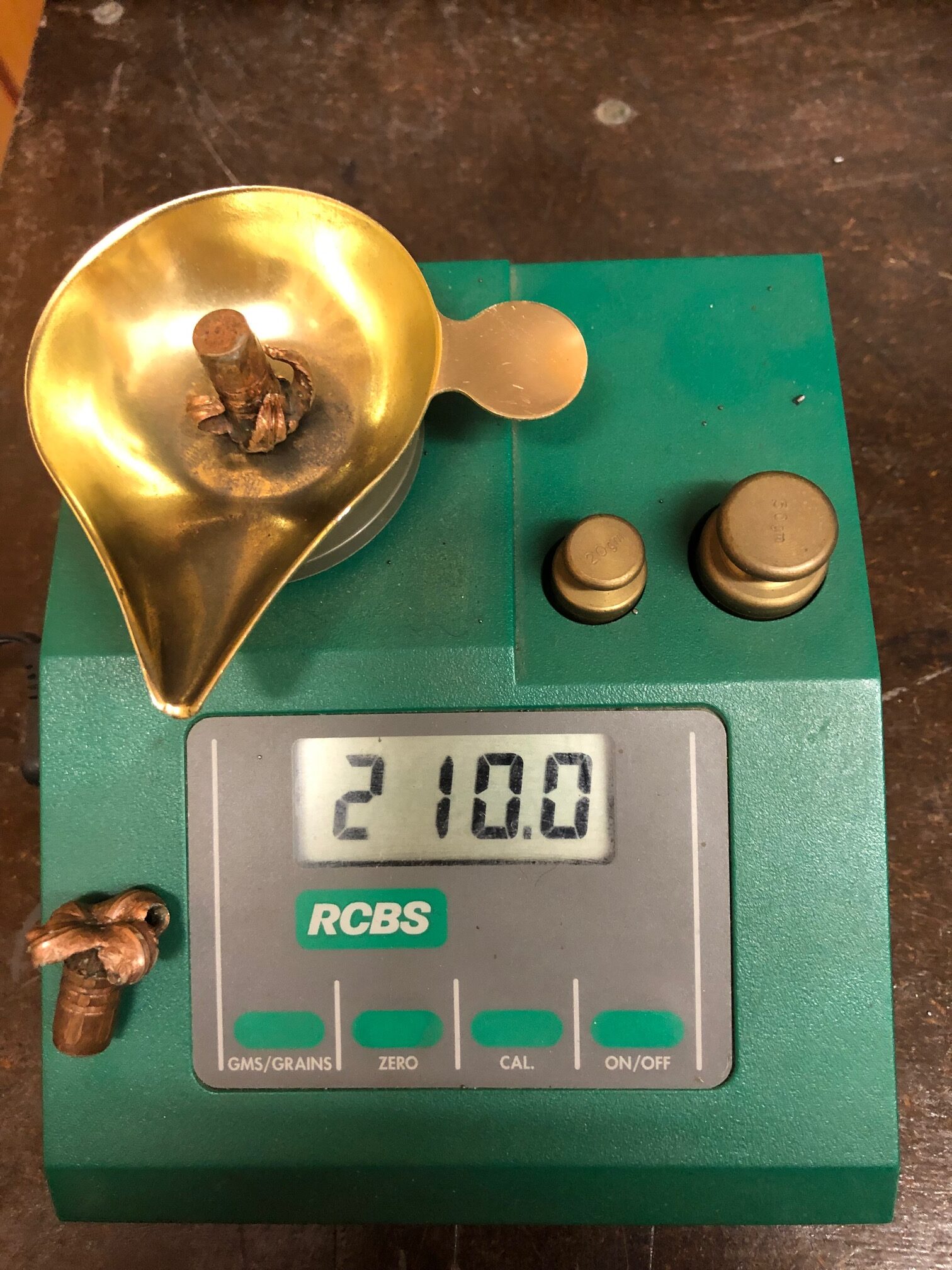
Copper 1 Finding this 210 gr. .338 caliber Barnes TSX fired from a .338 Federal opened my eyes to the effectiveness of copper bullets. Copper 2 shows where and when the bullet was found by my Sitka Blacktail hunting partner Bob. We were boning out these Kodiak deer using the gutless method when Bob felt the bulge under the front shoulder. This bullet ranged from just ahead of a hind quarter on a going-away shot, through the body and stopped against the hide on the off-shoulder. The amazing thing to me was it had not lost any weight. Copper 3 is the same bullet/rifle combination recovered on another Sitka Blacktail with a very similar shot and again 100% retention!
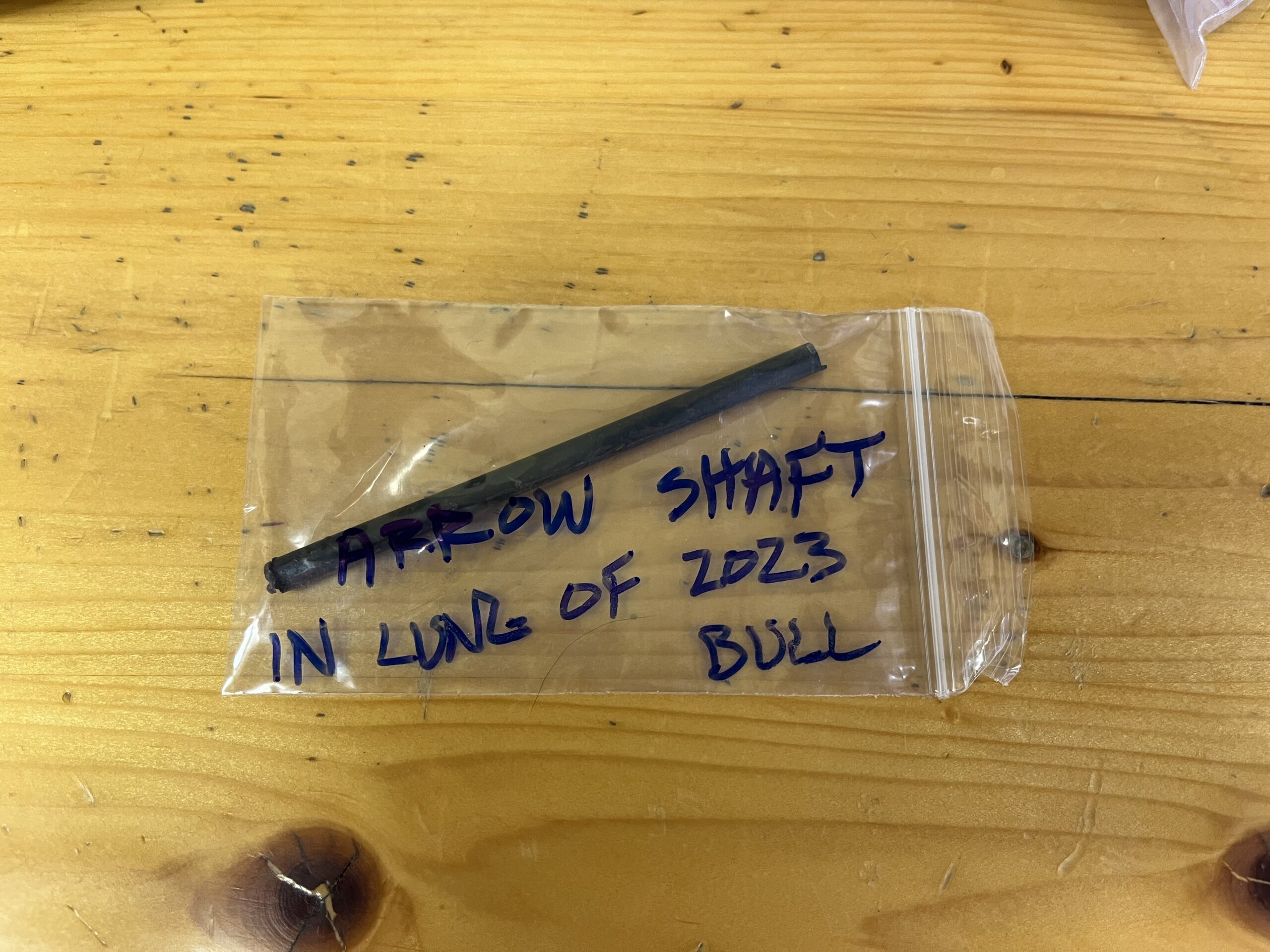
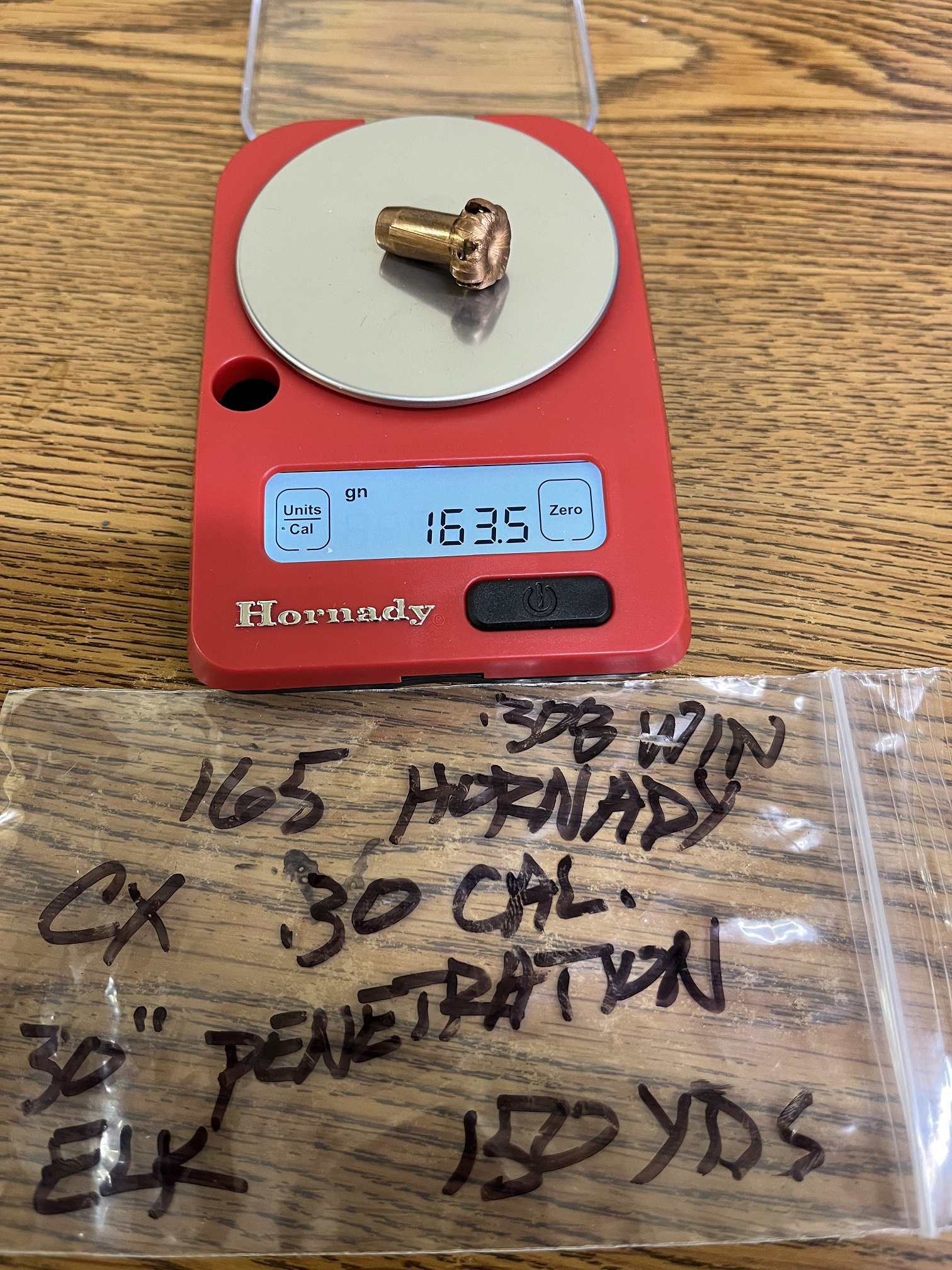

Copper 4 This obviously not a bullet. Rather it is an a broken carbon fiber arrow shaft that I found in a lung of the bull elk I shot in 2023. It looked like the archery shot was head-on and only one lung was penetrated. The broadhead had dissolved and just the broken-off shaft remained. The point is that these big bulls are very tough. The bull had completely healed from the arrow wound which was probably from the year before. I killed the bull with a copper 200 gr. Barnes TTSX from a .358 Winchester but it was a broadside pass-through shot. Copper 5 is perhaps the most impressive recovered bullet in all of this collection. It is a perfect mushroom shape and retains a long shank for deep penetration. This is from a cow elk shot at about 150 yards in 2023. She was quartering towards me and the bullet entered just behind a front shoulder and was found against the hide on the off-side right at the diaphragm. Penetration was about 30″. The bullet is a 165 gr. Hornady CX (new in 2022) fired from a trusty .308 Winchester. 99% retention and part of the 1% loss is the plastic tip. Copper 6 is another Hornady CX bullet. This one is a 150 gr. fired from Sally’s 7mm-08 and recovered from a cow elk in the 2023 season. The cow was about 135 yards from us and her first shot center punched the rib cage. But she didn’t go down after taking a step forward. I suggested another shot and the elk dropped instantly. Elk are tough, as Copper 4 clearly shows, and a follow up shot can be insurance and assurance of elk meat in the freezer. As it turned out a second shot was not necessary as both lungs were hit. The second shot must have hit some brush; it hit the elk directly in a hind quarter. There was a copse of little pines in front of us. The bullet broke the big bone on the close side and then again the same bone on the off side. We found it during skinning. 96% retention after ranging through both hind quarters and smashing two big femur bones as it went! Another benefit of using copper bullets, as friend Bob says; “You can eat right up to the hole.”
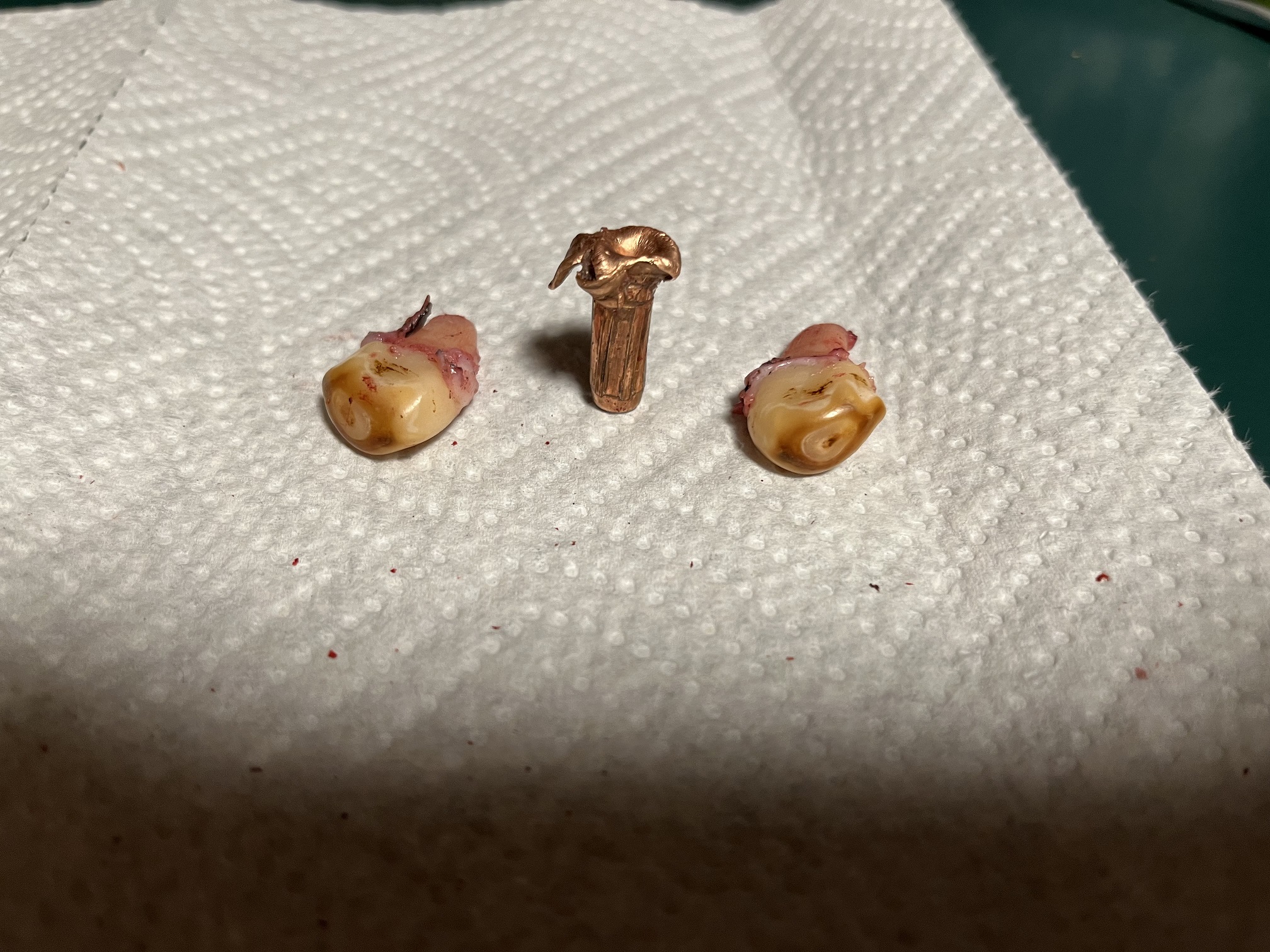
Another look at Copper 6 along with the fresh gorgeous ivories.

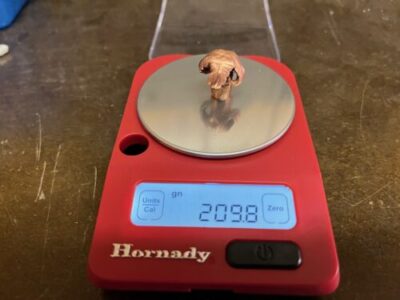
Copper 7 is just a small piece of broken off mushroom from a Hornady .30 caliber 140 gr. Monoflex bullet recovered from a whitetail doe. It is centered in the little ziplock holding the doe tag. I have an old Winchester M. 94 in 30-30 that I’ve used on two does now, both with this bullet. I bought this metal detector, a Pin Pointer as they’re called, to help find bullets in meat. So far this is all I’ve found with it. Both shots with the 30-30-killed does were close-range pass-throughs. Copper 8 is a 210 grain Barnes TSX .338 caliber bullet fired from a .338 Federal and recovered from a 2024 bull elk. Retained weight is 209.8 for a nearly 100% retention.
As I update this in November 2024 we have killed nine whitetails, two Sitka blacktails and five elk with copper bullets in the last three years. The cartridges used have been a 6.5 Creedmoor with the 120 gr. Hornady CX on a whitetail buck, three whitetail bucks with the 150 gr. CX from the 7-08, one whitetail buck with a 165 gr. CX from a .308 Win., two blacktails with the 210 gr. Barnes TSX from the .338 Federal, two whitetail does with the 140 gr. Hornady Monoflex from the 30-30, one bull elk and a whitetail doe with a 200 gr. TTSX from a .358 Win, a bull elk with the 210 TSX from a .338 Federal, a cow elk with the 165 gr. CX from the .308 and two cow elk with the 150 gr. CX from a 7-08. Based on the results from these kills I know there will be more. The CX and TSX and TTSX bullets open up and penetrate as well or better than any other bullets I’ve used. Here is a picture of the lungs (the bullet entered into the right lung and exited the left lung) from a 2024 whitetail buck shot broadside at about 100 yards with the 150 gr. CX fired from a 7mm-08.
Another advantage to using a copper bullet is when turkey hunting. Montana allows the use of handguns and rifles during the fall season and I killed a couple of Toms in November of 2024 using an XP100 handgun and shooting the 6mm 80 Grain CX bullets from a 6×47 chambering. With a body shot the bird isn’t sprayed with lead leaving all of the meat edible.
The Barnes TSX bullets open up with 4 petals, like an X shape, and a large expanded diameter. The Hornady CX bullets open up with 6 petals and the expanded diameter does not seem to be quite as large as the X bullets. The CX mushroom shape is much like an expanded bonded bullet. The 4-petal Barnes bullets have an open area between petals and these petals always have tissue in the openings from tearing through flesh.
Another copper bullet that I have not tried are the Hammer Bullets. I’ve heard good reports on these and may be trying them soon. Watching a YouTube video on Hammer bullets indicates that they designed to have the petals break off.
Killing deer size game for the most part doesn’t require a tough controlled expansion type bullet. An exception might be a very big mature mule deer buck or big horn ram or the use of a small caliber bullet, like a 6mm or .224. But when you get into game animals the size of a cow elk and larger, in my opinion, it does matter. Not all shots are clean broadside opportunities where getting into the lungs or heart is easy. Elk and moose are built with big bodies supported by big bones. A quartering shot may be all you’re going to see and maybe for just a brief moment. Using a controlled expansion bullet that retains much of its weight ensures that the bullet can make its way to vital organs.
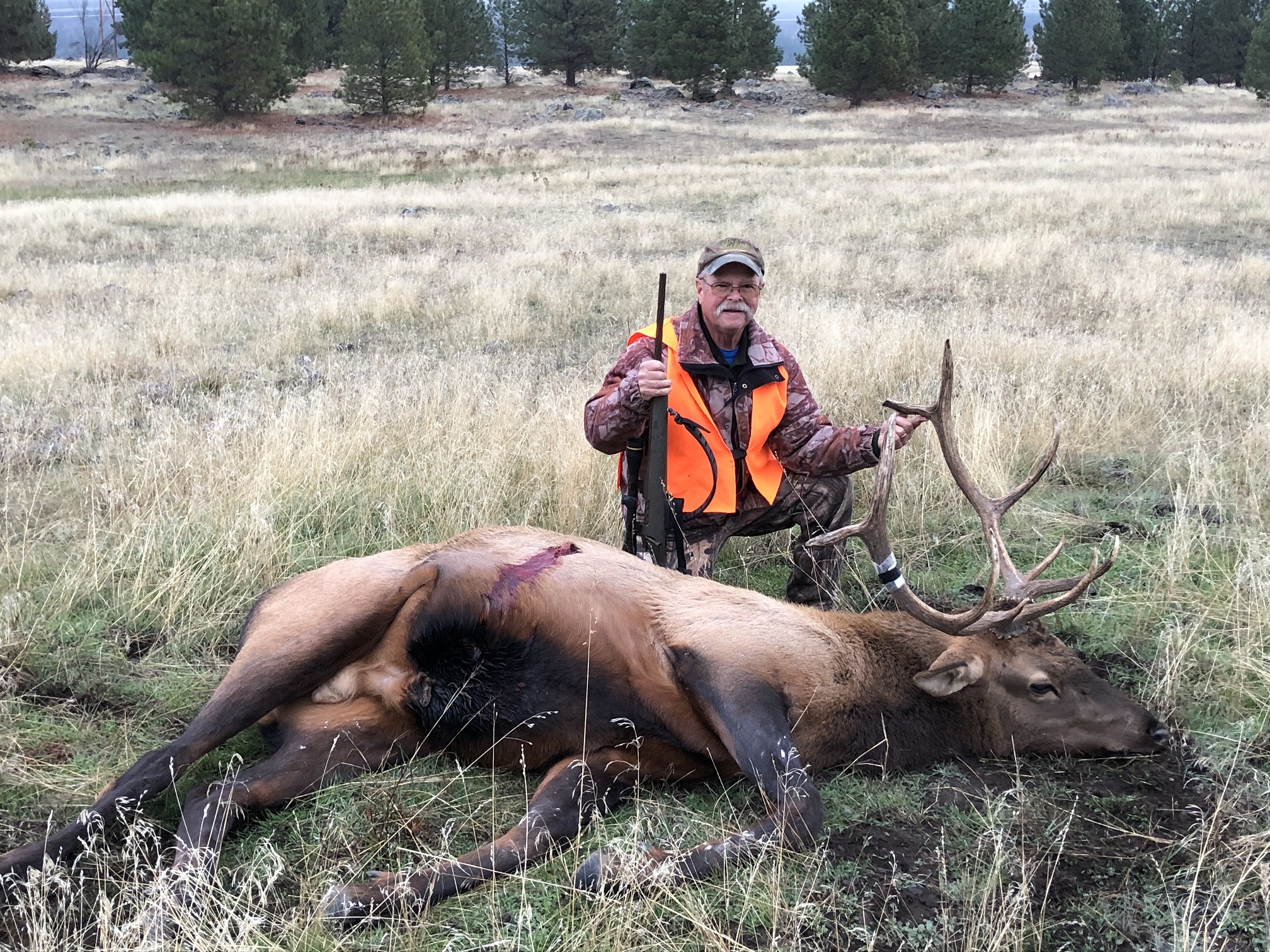
This good size bull from the 2022 Montana season is an example when a stout, controlled expansion bullet, really shines. I was back in the trees the direction this bull’s rump is facing. Some cows were moving from my left to right through this opening just after daylight headed for a bedding area. I was watching them from behind a table-sized flat rock. Soon this bull appeared and then turned heading away from me. I had brought along my 6.5 Creedmoor for this hunt loaded with 130 gr. Nosler Accubonds. The distance was about 180 yards and as the bull stopped for a moment I held on where I thought the diaphragm would be, planning to angle the bullet into the lungs. At this angle there was a narrow window between the big hind quarter and the shoulder. The Creedmoor and I both did our part and the bullet hit as planned. The bull stood in place for a few moments and then fell onto his side. The bullet went into both lungs and is Bonded 2 above. I consider the 6.5 CM to be on the light side for elk. I’ve seen two cows killed with this cartridge by others, using premium bullets, and though both soon died neither showed much reaction to the hit.
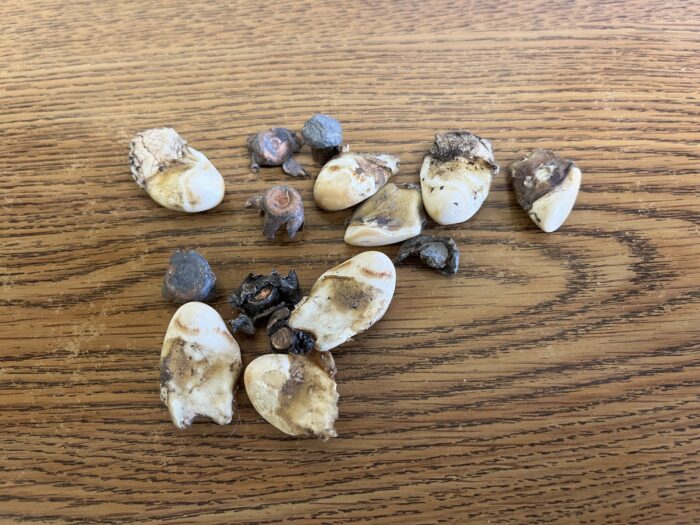
Keeping good notes over the years can be important. Here’s a few recovered bullets I’d kept in a little box with elk ivories but no notes on the bullets……..
We will update this article as we find more of these copper/lead nuggets.

